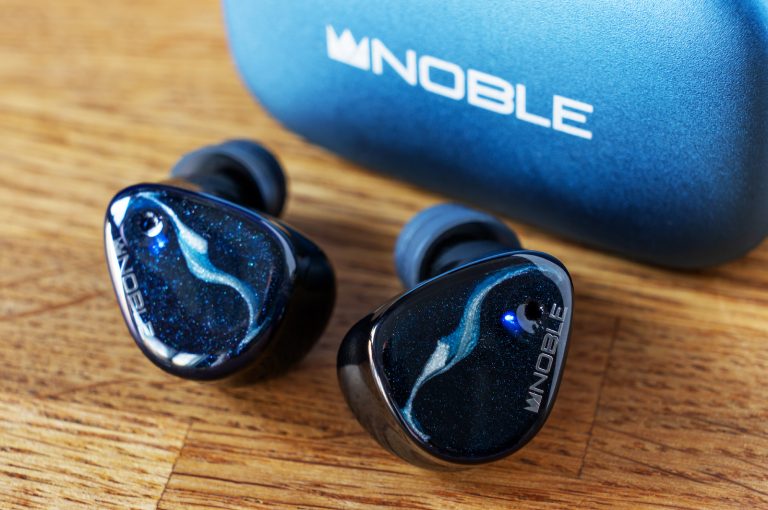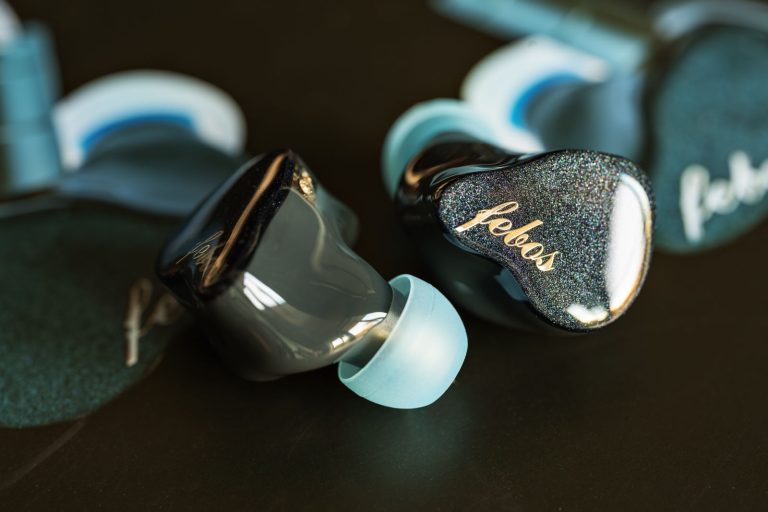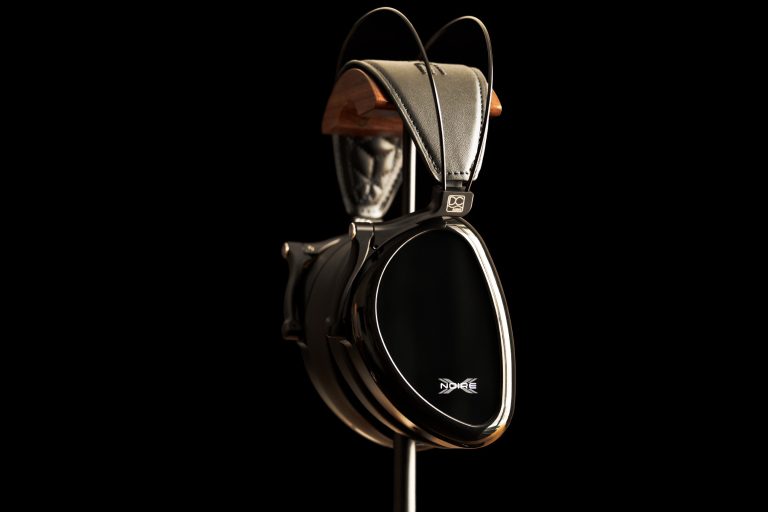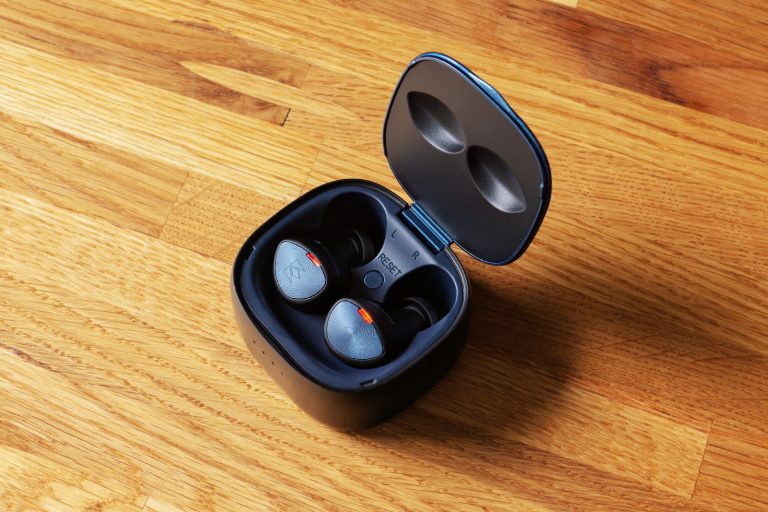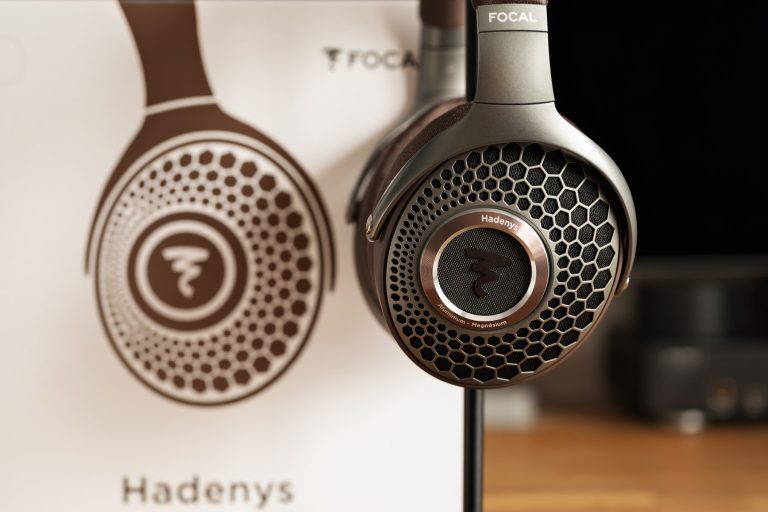Dan Clark Audio E3 Headphones Review
Immediately after I had published my review of Kennerton Arkona, stormy comments like “It’s just because you’ve never tried E3!!!11” rained down. I wondered what the matter was, so I went and bought them. So, today I’m gonna talk about them – about Dan Clark Audio E3. Closed-back planar headphones cost $2,000.
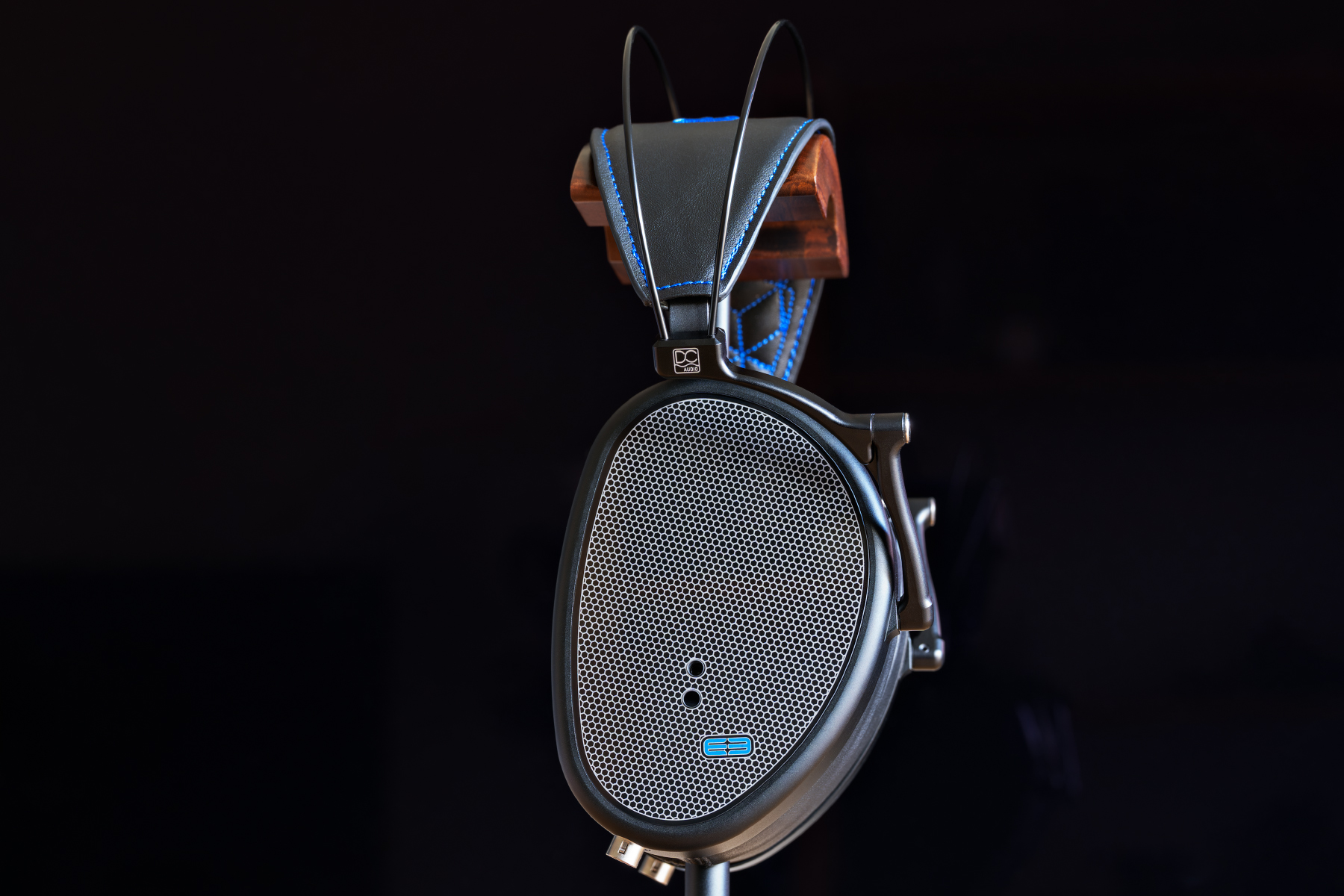
What’s included
The box is discouragingly small for headphones of such value.
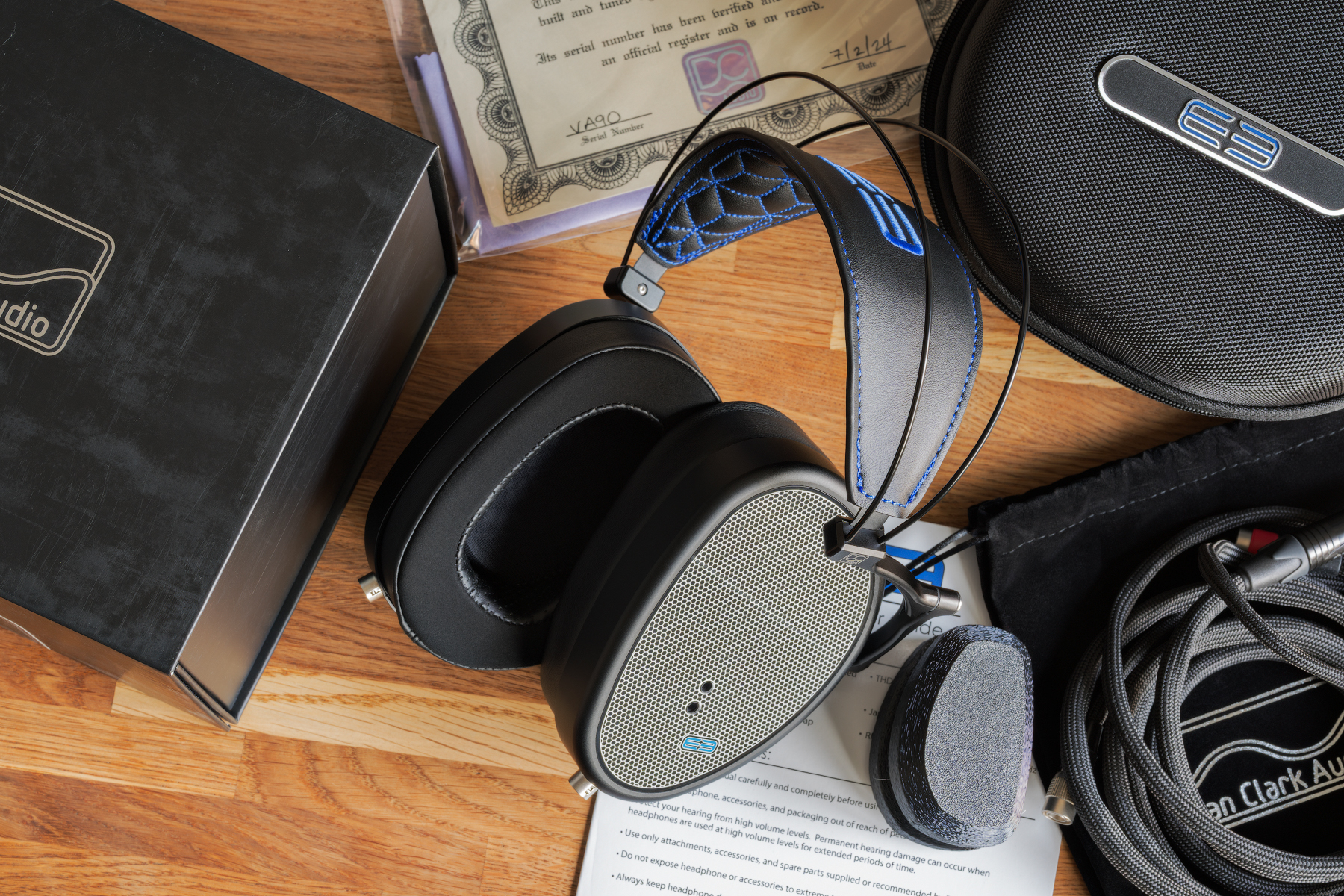
Here’s what’s inside:
- The headphones themselves.
- A 3D printed spacer so that the earpads are not deformed by pressing when the headphones are in the case.
- A VIVO cable. In my situation, it has a 6.3 TRS connector and is 1.8 meters long. It can be purchased separately for $300.
- A pouch for the cable.
- A hard case.
- Some papers.
All this is framed with a hint of utilitarianism and versatility, which appeals to me personally very much. No iron trunks like Meze’s or funerary-like black velvet boxes like Focal’s – everything is strictly to the point.
Quick specifications overview
- Design: over-ear, closed-back.
- Driver type: planar.
- Impedance: 27 Ohms.
- Sensitivity: 90 dB/MW at 1 kHz.
- Connectors: SN-8-4 (Hirose 4-pin).
- Weight: 460 g without cable and 566 g with cable.
Design, assembly, technology
The headphones, as any model worth its salt, have a number of technological features.
The driver is of the ‘fifth generation’, according to the grading from the manufacturer itself. The Stealth model, for example, has a fourth-generation driver. The dimensions of the membrane are 76×51 mm, this is how its virtual prototype looks like:
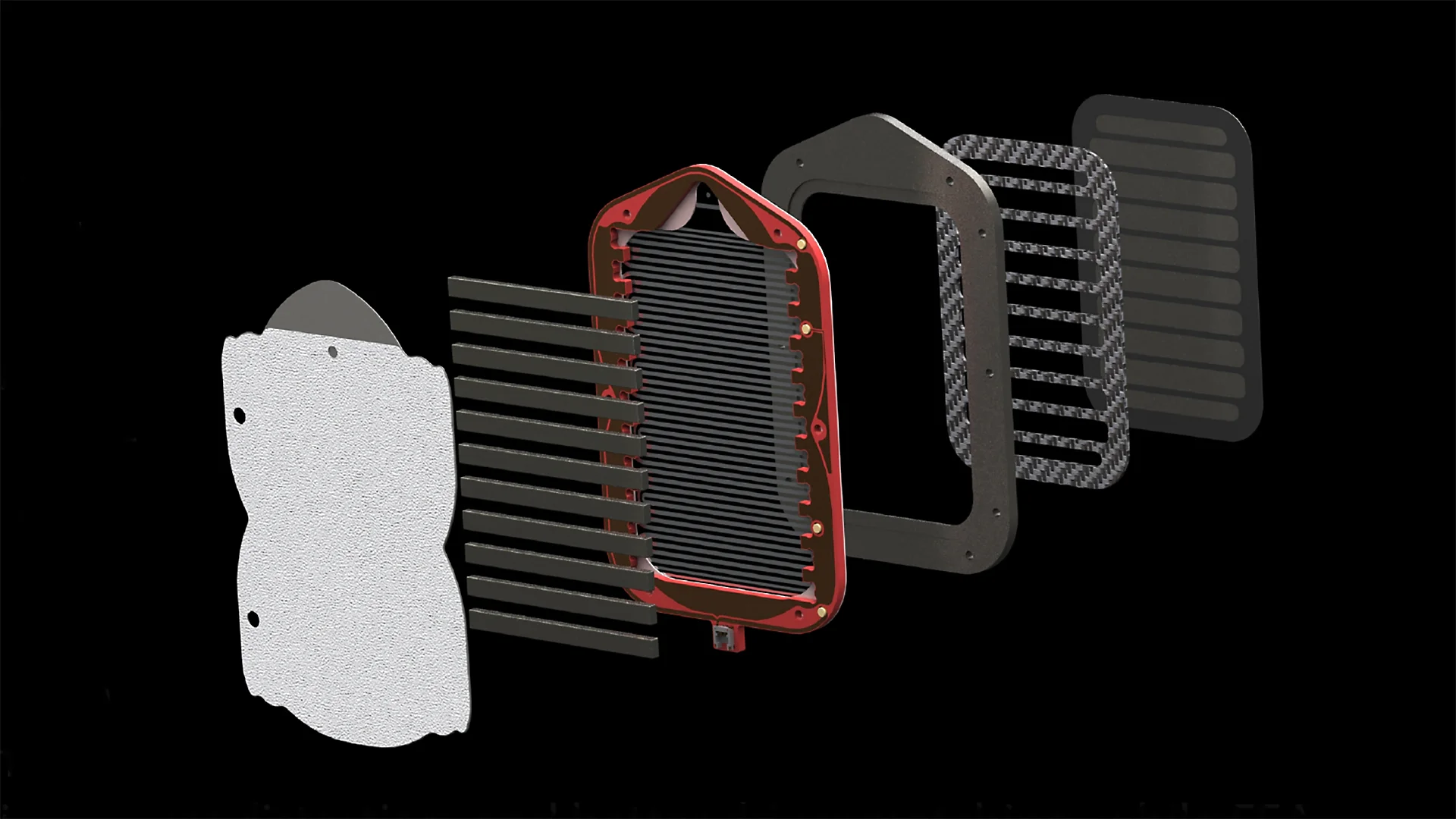
And this is how the real E3 driver looks like:

AMTS (Acoustic Metamaterial Tuning System) is a (sound) tuning system based on metamaterials. It’s a 3D printed acoustic filter located between the driver and the listener’s ear. The filter has a cellular structure and is also equipped with extra miniature sound ducts. Every cell can act as a resonator of a certain length and diameter, as well as block certain frequencies. It’s known that AMTS influences upper middle and upper frequencies. This is how its model looks like:
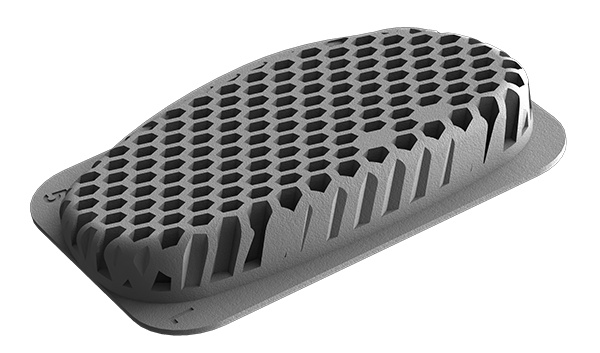
And this is how the real AMTS filter looks in E3:
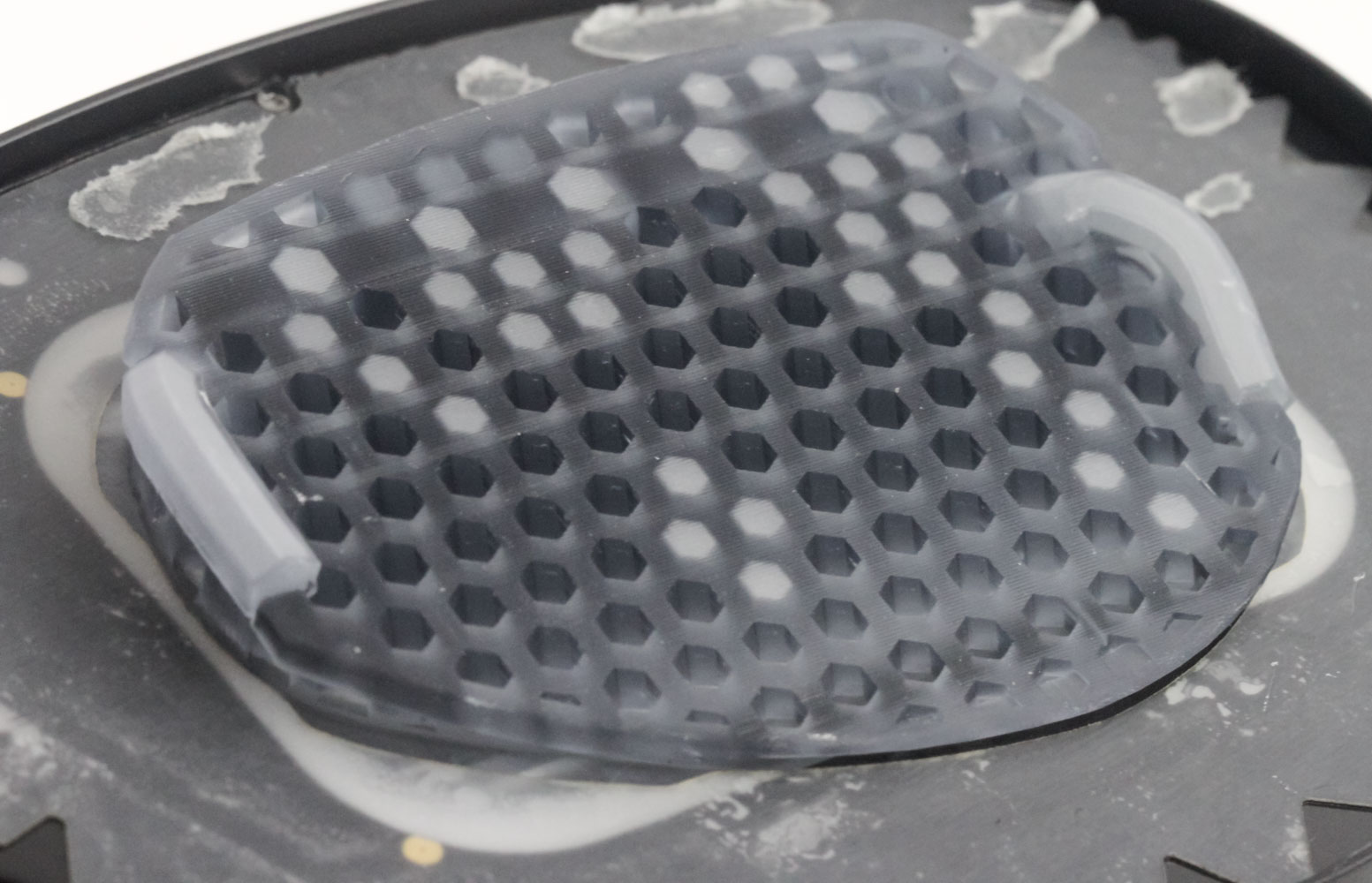
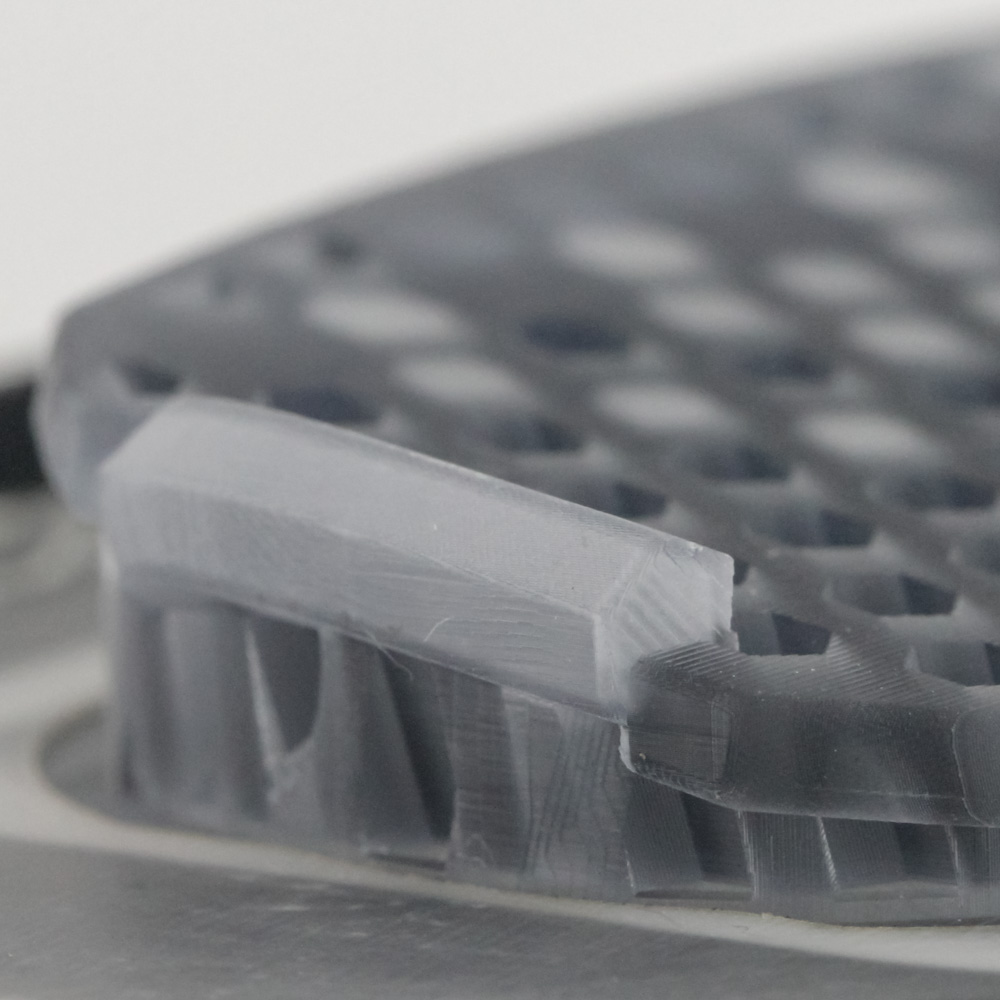

Other ends and outs:
- Gorilla Glass 3 polymer glass is used as the material of outer surfaces of the earcups.
- The headband arcs are made of nitinol, a compound of titanium and nickel. Nitinol has a shape memory, that is, when heated to 40°C, an article made from nitinol restores its original shape. In the specific context of headphones, this makes it possible to significantly bend the headband without its plastic deformation and also allows E3 to fold, and this is why their case is so compact.
The E3 style is elegant high–tech minimalism. The earcups are entirely made of metal. The two-piece arms, also metal, ensure the rotation of the earcups around the horizontal axis.
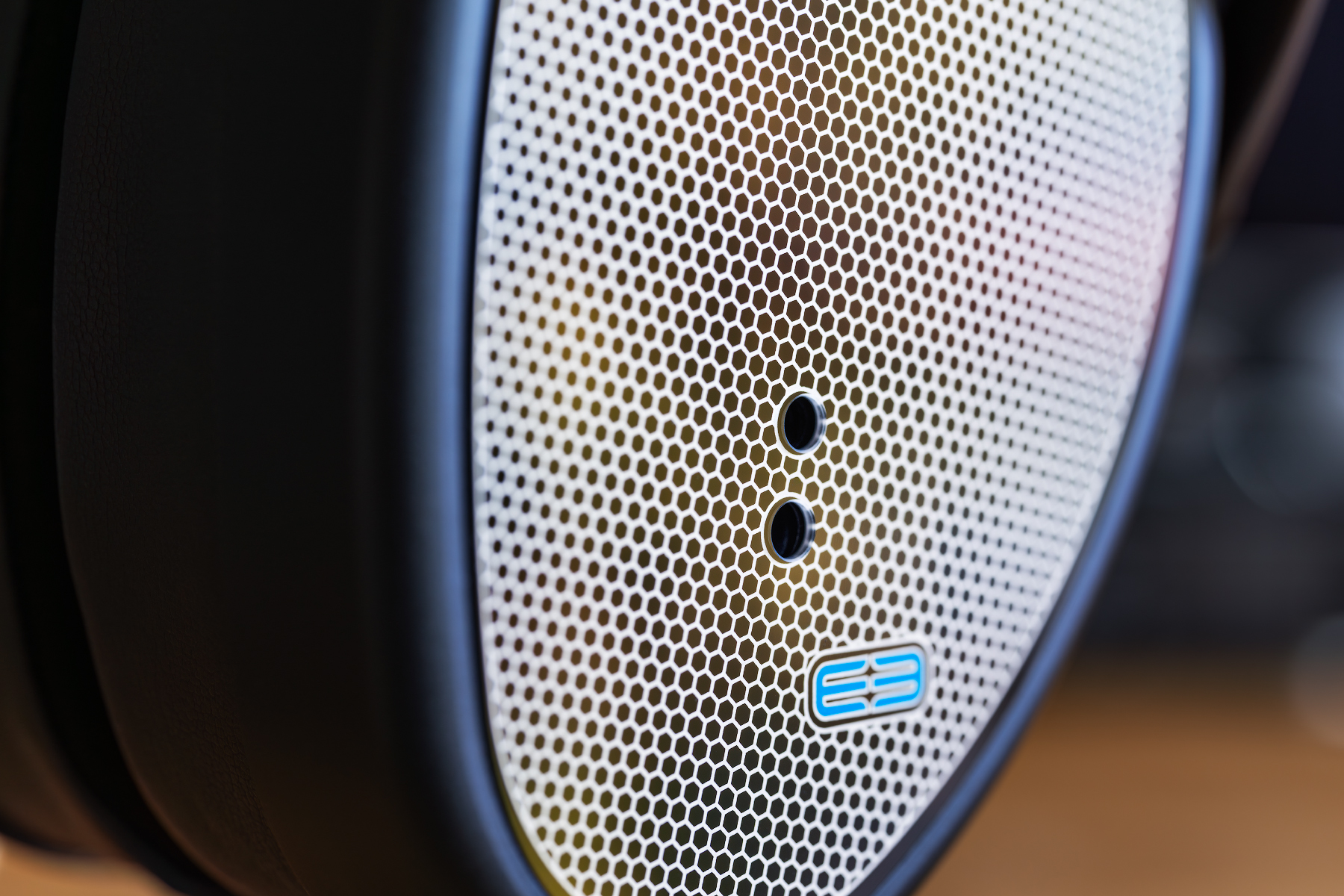
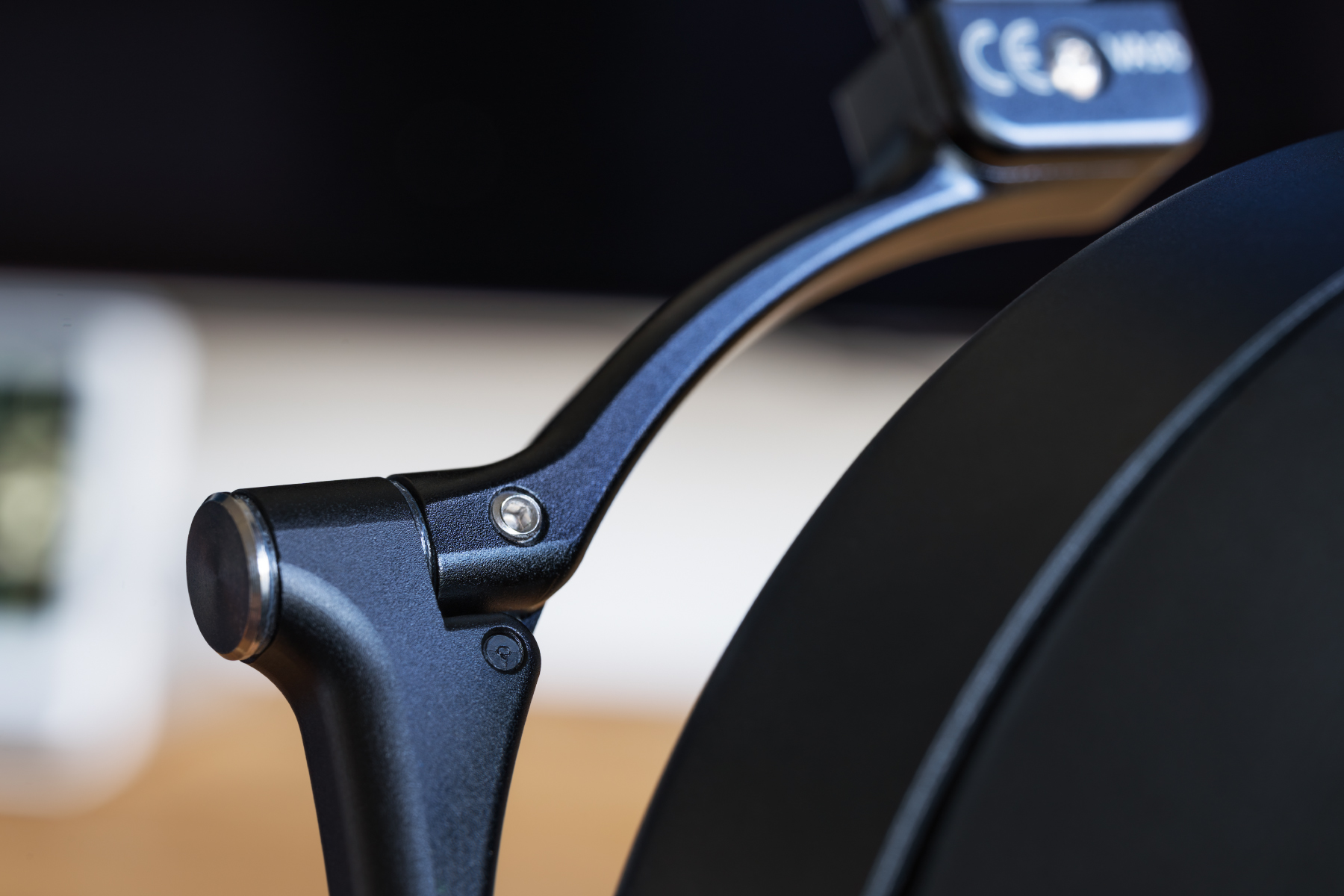
The headband is made on spring suspensions, it’s self-adjusting. The support plate is leather.
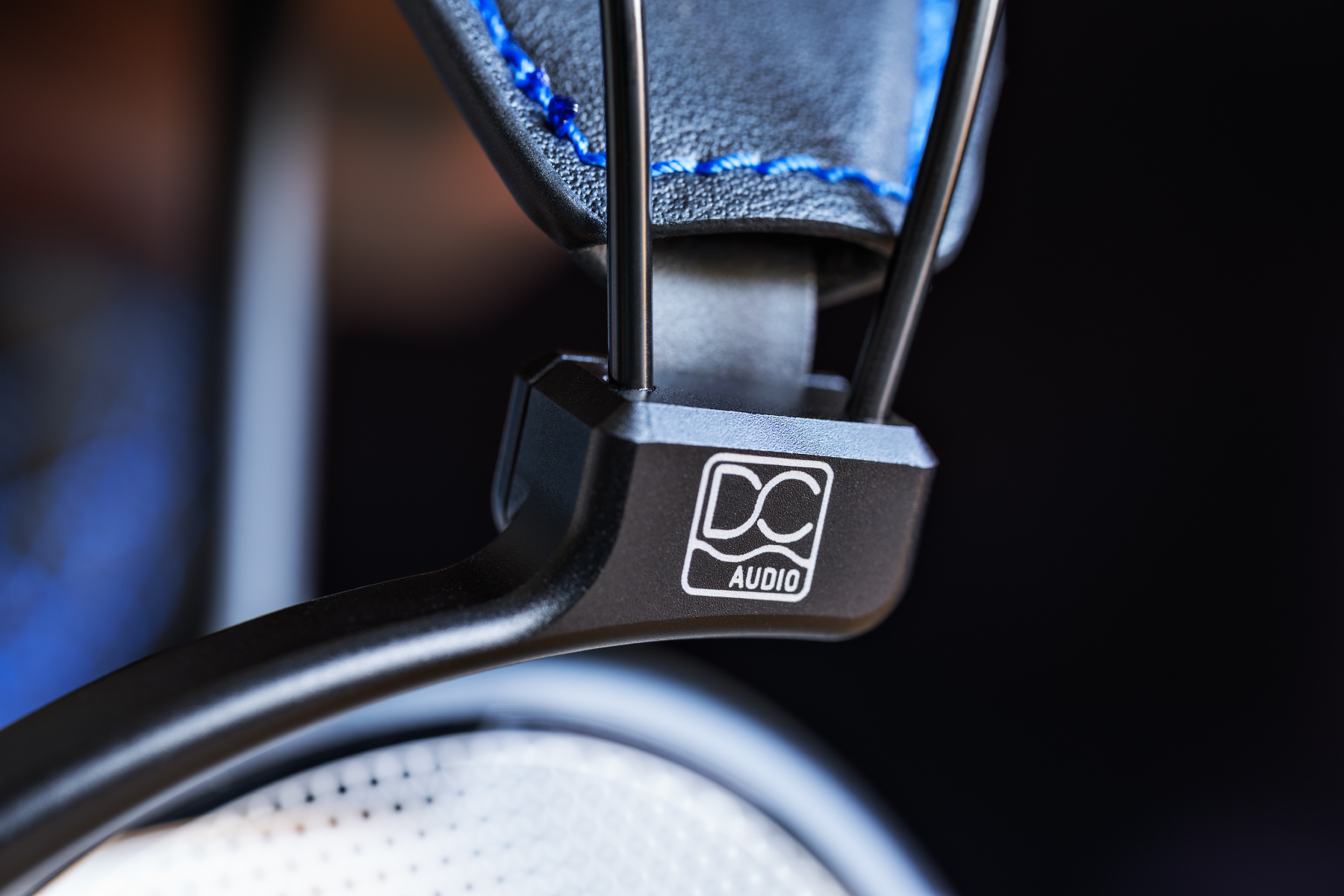
The key color is blue in contrast with the red color used in design of the Stealth model.
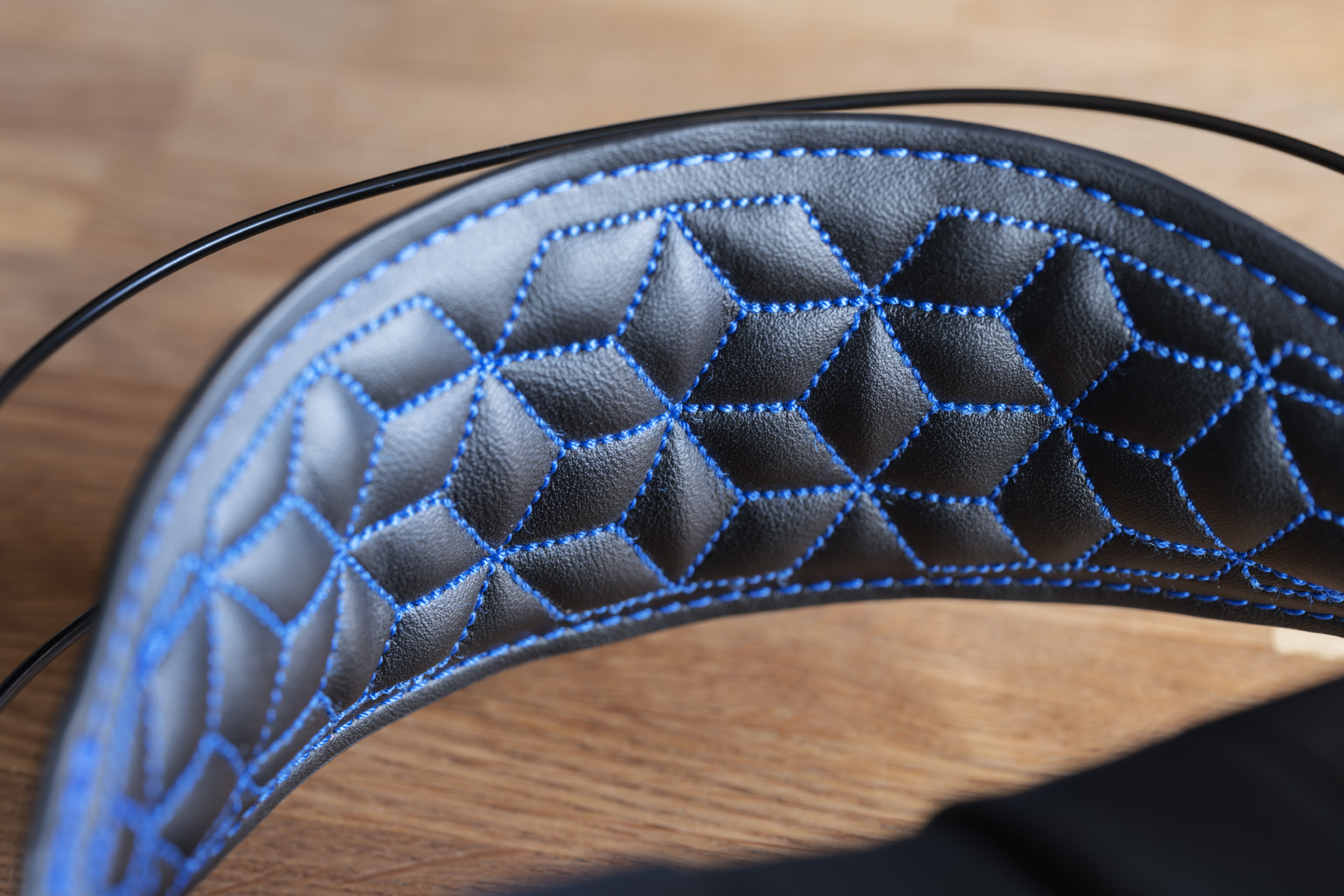
The connectors are oriented at an angle to the vertical axis. The earpads are removable, but held on an adhesive layer.
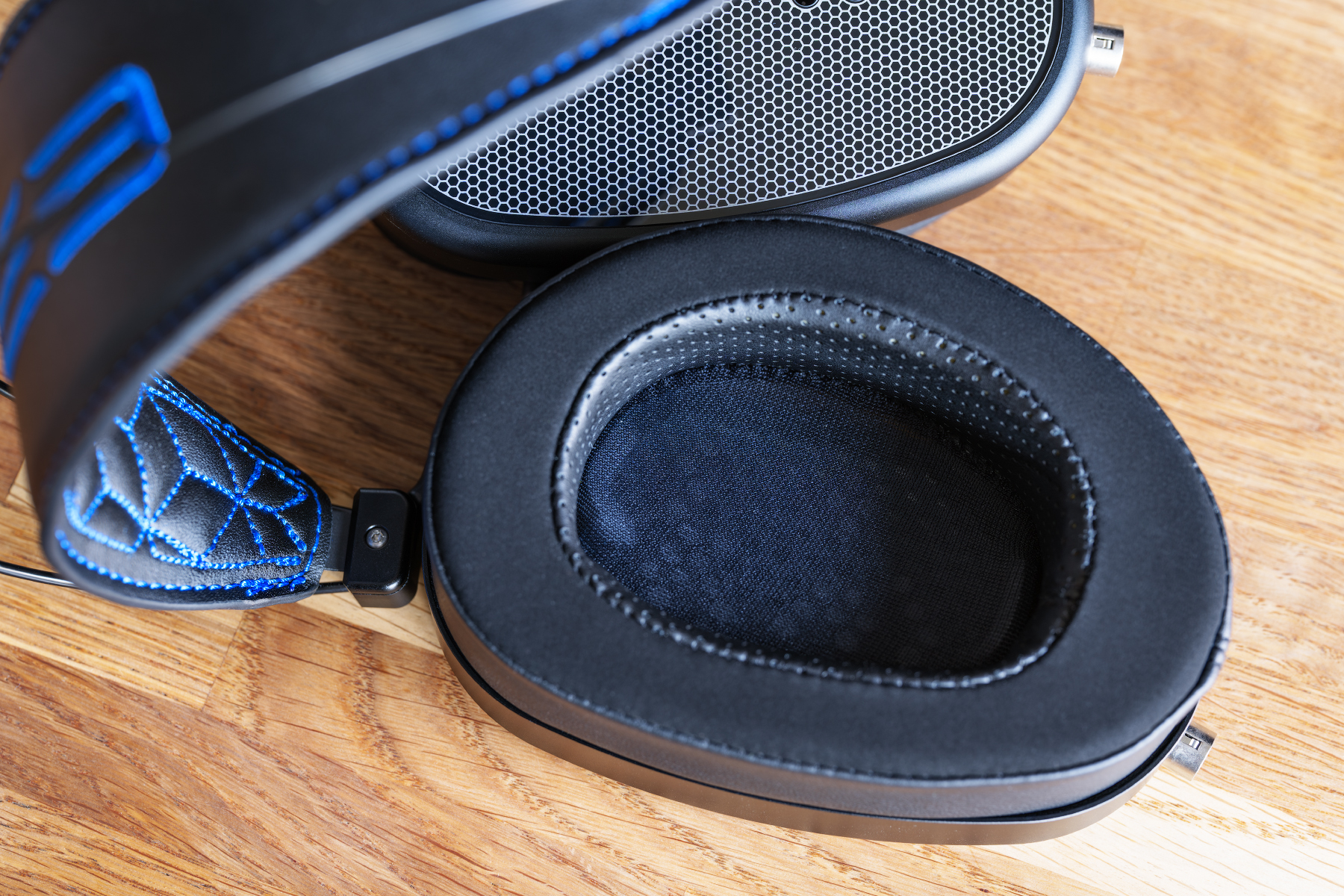
All in all, it’s nice enough, except for two things.
Maintainability. It raises a lot of questions because, judging by the available pictures of the E3 insides, the vast majority of the details inside the earcup are just glued (taped).


That is, it’s possible to disassemble and unglue it all neatly and without breaking it, but it will require outstanding skills and a ton of patience.
Earpads. The earpads glued (taped) to the earcups are, in my opinion, totally nuts: as an extremely careful user of expensive devices, I don’t have an opportunity to remove the earpads, clean them, and put them back on. But come on, fuck the cleaning: as for my sample, they are taped not quite symmetrically.
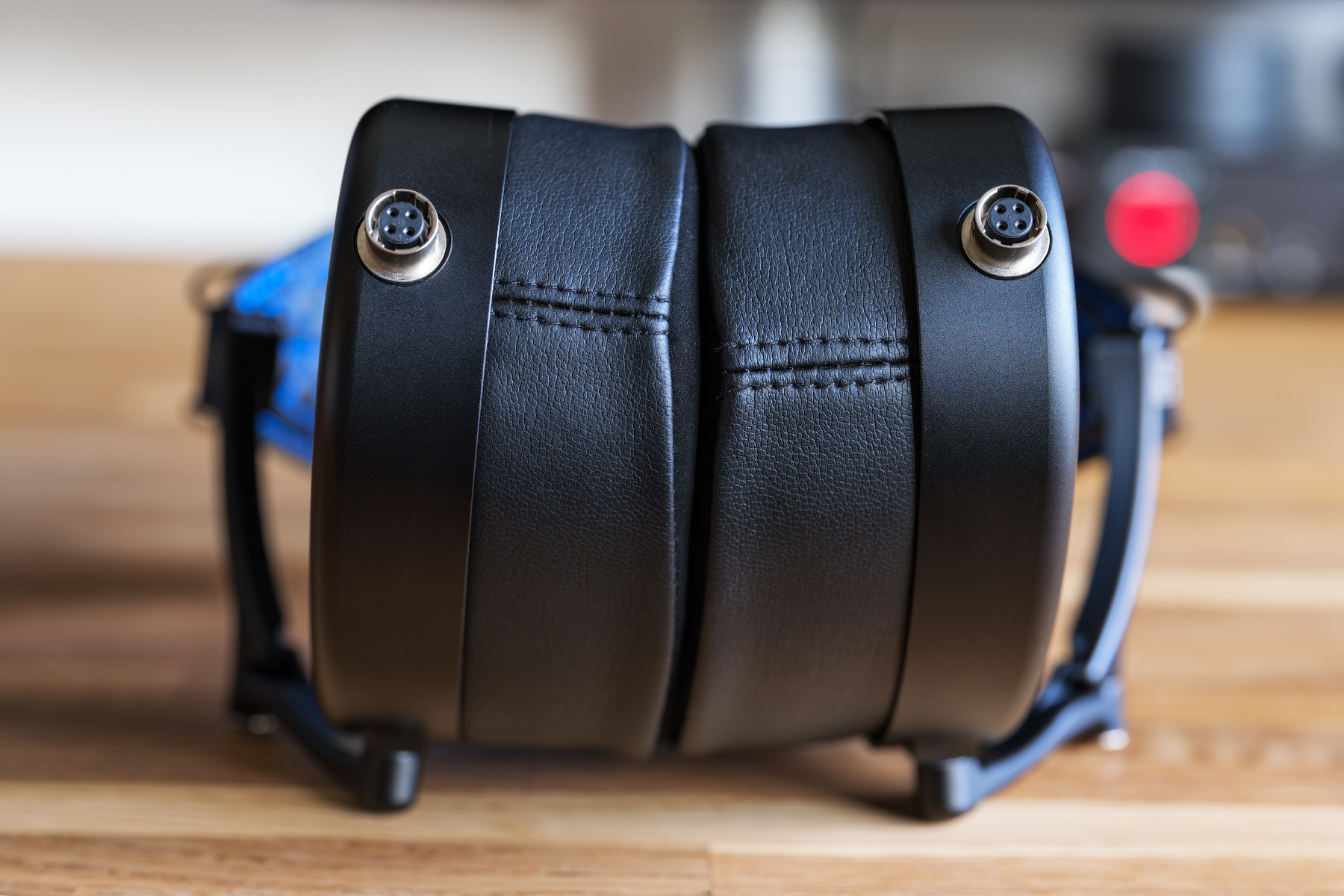
And I can’t fix it in any way, I can only buy new earpads and attach them more carefully than the manufacturer did.
Dear Dan Clark, why did you do this? You wanted, like, to avoid an air gap, huh? But many manufacturers manage that without gluing. Actually, DCA headphones are the first and may be the only (Audeze did) headphones where a solution like this is actually used.
Ergonomics
Best things first.
The headphones sit on your head comfortably. It’s not without nuances, which are discussed below, they’re not like Meze Empyrean yet, but you can easily stay in them for 8-10 hours at a time. Very comfortable earcup pressure, correct width and stiffness of the plate, correct cable connection angles – everything is done wisely.
E3 has a really unique ability – they can fold. Like, for real, pick up a spacer provided.

Insert it between the headphones and turn the headband down.
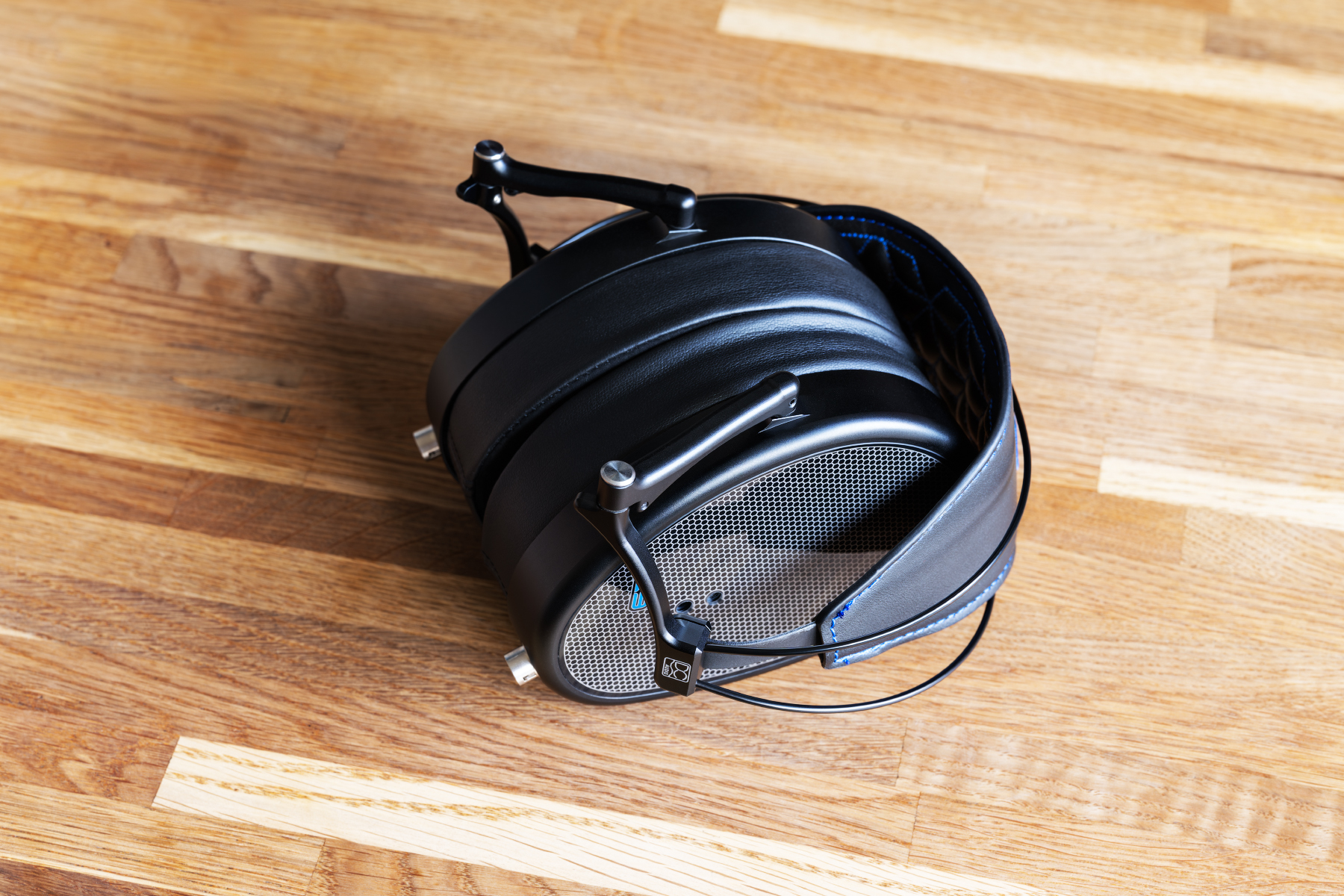
And put them in the case.
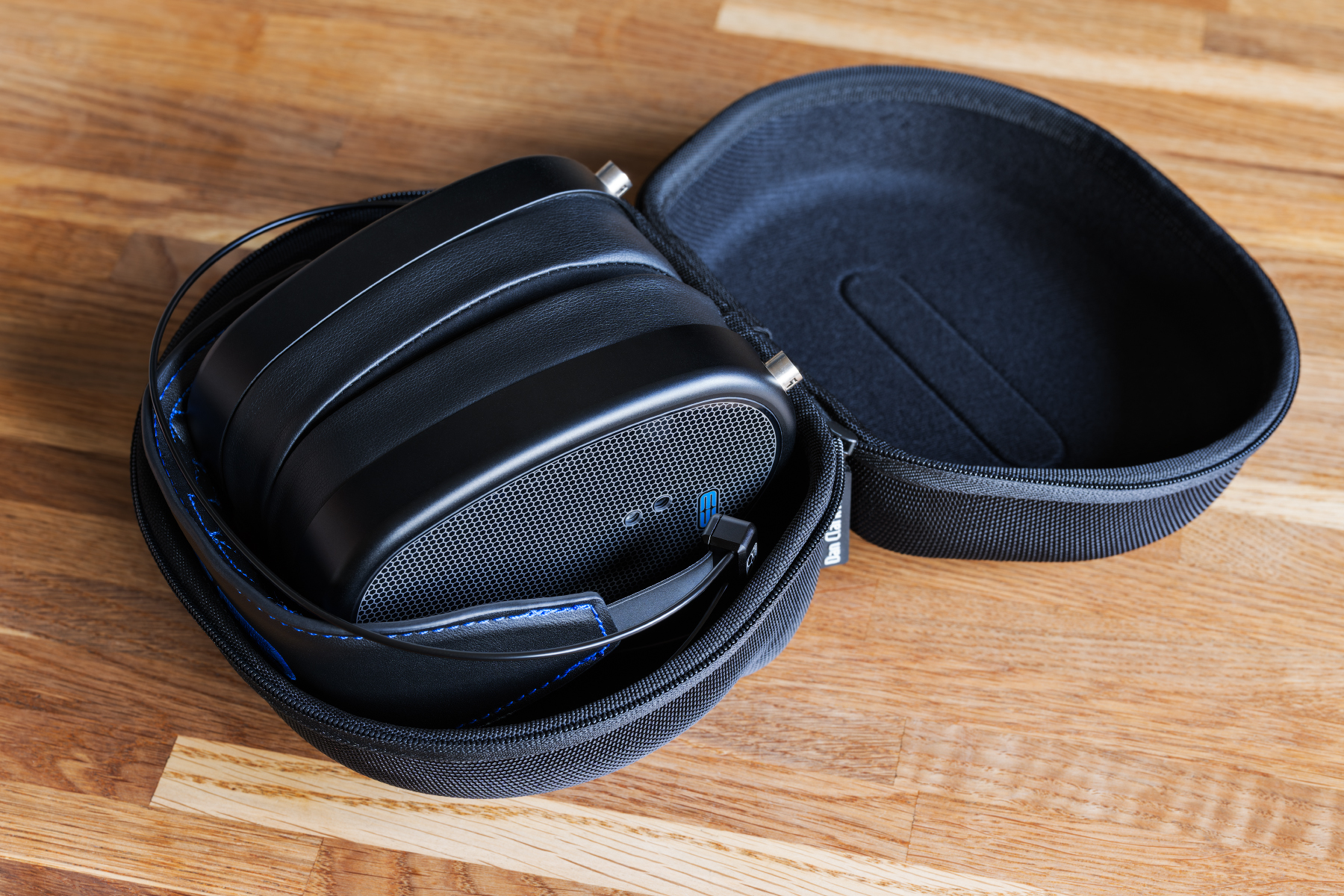
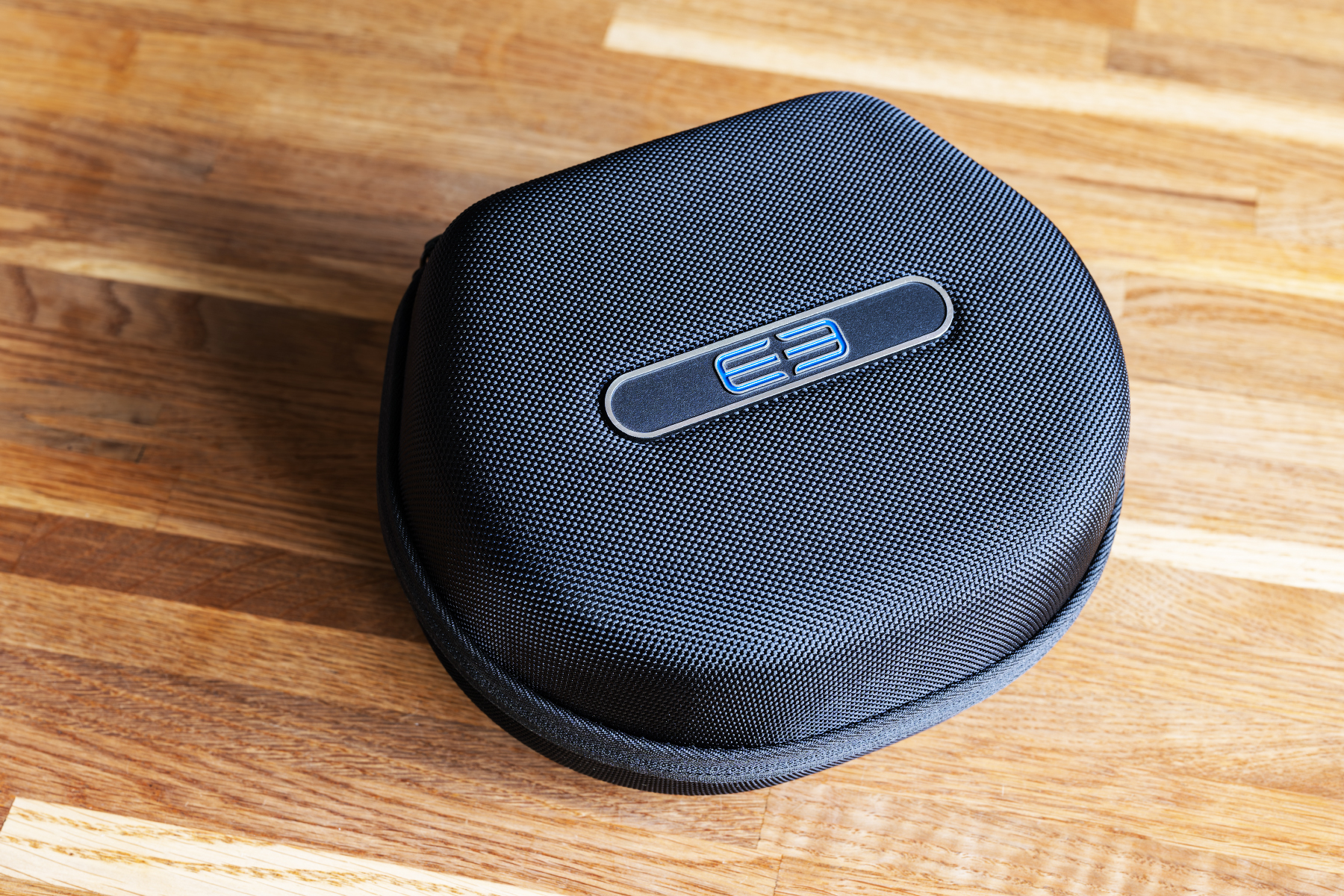
Isn’t it cool? It’s very, very cool, without any irony.
And now we move on to the nuances.
Going on talking about the case, the headphones do fit into the case, but the cable doesn’t. That is, the headphones can fold into a really miniature case, but you’ll have to carry the cable separately. They could at least make a mesh pocket for it, couldn’t they?
By the way, the VIVO cable is totally unhandy. Firstly, the cable’s weight is 106 g. There’s a metal splitter dangling in the middle, which seems to provide half the weight of the cable.
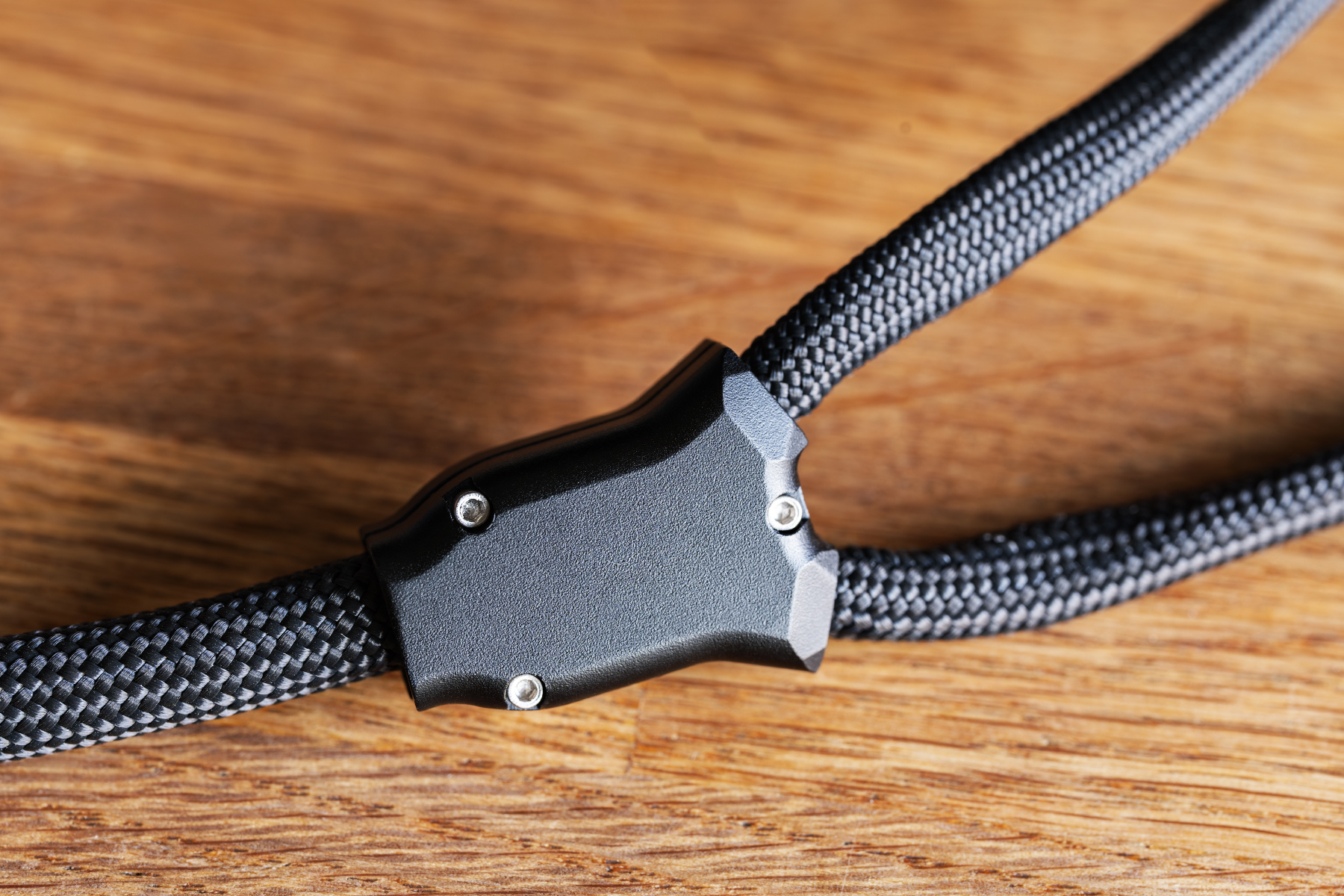
The cable itself is thick, in a plump braid, it hardly bends. In addition to this, the cores inside the braid intertwist all the time, and I can’t untwist them somehow.
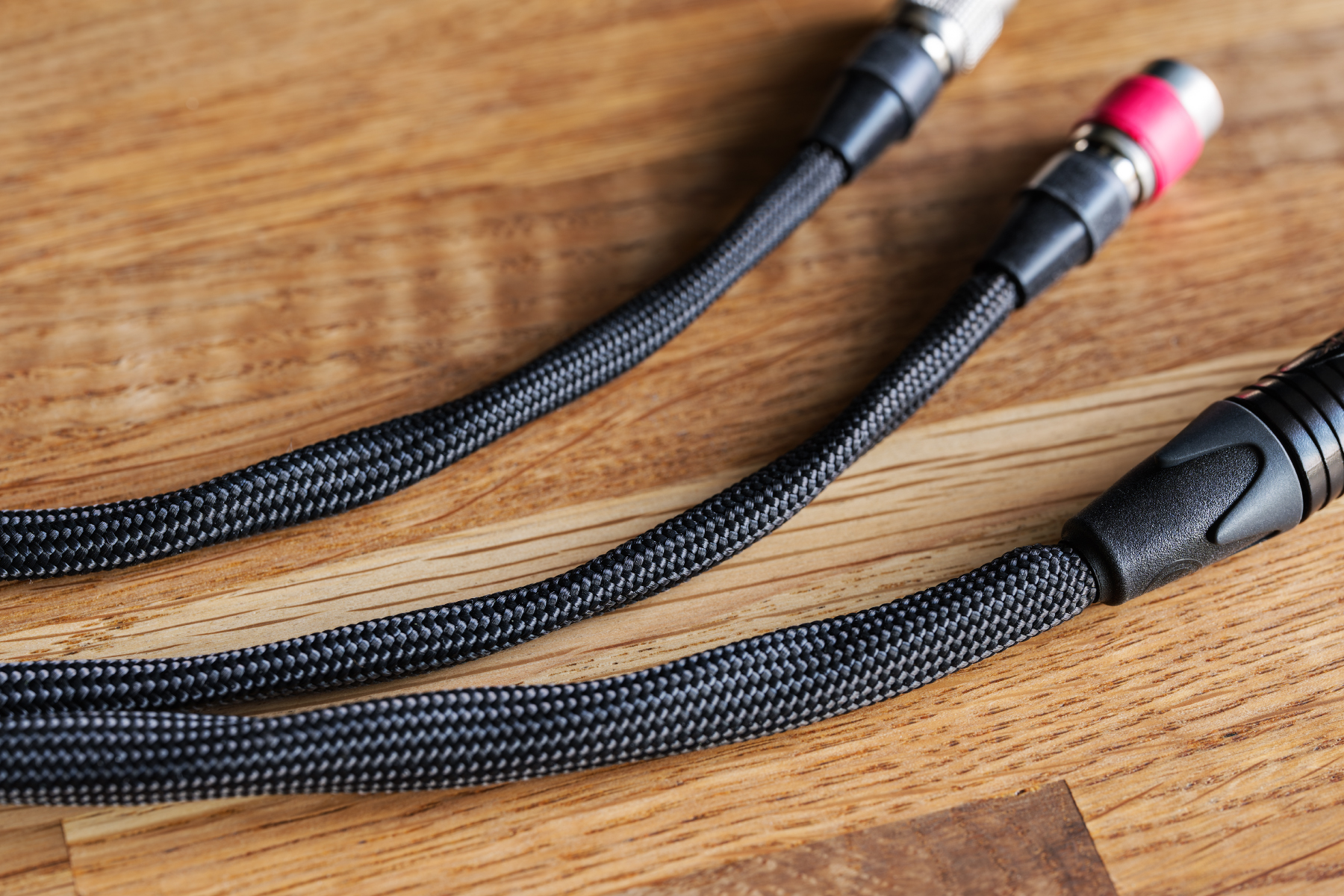
To cut it short, I couldn’t stand it and almost immediately ordered an ivipq-202 from ivipQ company. It sounds exactly the same, it’s completely identical to VIVO in measurements, but it’s convenient to use it. I don’t mean that you have to get it and it only – I mean that the original cable is bad. It’s not an ‘IV tube’ by Sundara yet, but pretty close already.
Connectors. Of all headphone manufacturers, only Dan Clark Audio uses SN-8-4, so you’ll have to buy cables specifically for these headphones – if you don’t have any other headphones from DCA yet, the other cables you have will definitely not fit.
And now let’s move on to the main… gray area.
E3 have huge earpads. To be more exact, they are very ‘long’: almost 13 cm. Even with my rather large head, I have to spend a while every time to find the position of the headphones on my head so that there are no noticeable gaps between the earpads and my skin. I have a constant problem with the angles of my jaws: the earcups sort of ‘fall into’ these dimples with their lower parts, and their upper parts bulge out because the mounts to the headband are located almost in the middle of the earcups length.
Therefore, for the first few days, until I began to feel the earpads on my head with my hands, I was frankly perplexed: according to the measurements, the subbass should have been… should have been present, but my ears couldn’t hear it. Let’s note that I have a 3 mm haircut and don’t wear glasses. Therefore, earpads usually sit on my head very tightly.
In the long run, you need to learn how to position E3 on your head so that the sound is what it should be like. I personally have to move the headphones forward and up.
And here are some obvious answers to the ‘questions from the floor’.
Does it seem that the use of glass for the exterior decoration of earcups will be a problem? No, it doesn’t because it’s almost impossible to put the headphones on their side, glass on the table. And the glass itself seems to be quite durable. I haven’t tried dropping E3. On second thought, I have never dropped any headphones.
Do the thin headband arcs somehow affect the sound? Are they supposed to ring? No, neither by ear nor by measurements do they affect the sound in any way.
Subjective sound impression
The E3 sound is very precise, with a slight emphasis on the upper middle. At first, it seemed to me almost sterile and ‘light’, but after adjusting the fit and eliminating the gaps between the earpads and my skin, it became clear that bass and subbass are in place as well. Therefore, I would call the E3 sound delivery neutral-cold: the upper part of the midrange dominates the sound picture, taking the listener’s attention away from a slight emphasis on the subbass and from the lower frequencies in general.
As for the subbass and bass, to my ear and, apparently, due to the above-described fit specifics, the subbass and bass are allotted literally at the lower acceptance limit. The lower frequency range is ‘fast’, with fast attacks, it ‘gains weight’ if the track so requires. But it’s not enough in terms of quantity, it’s really extremely reserved. And this is me saying that as a big fan of neutral delivery.
The midrange is just awesome. Lined up perfectly, it’s clearly pushed forward – E3 know how to transmit sounds very closely, literally ‘whispering in the ear’. Of special note is the upper middle near 4-8 kHz: it’s audible extremely well, but never gets sharp. I’m ready to admit that I can hardly remember any headphones similar in this regard.
The upper frequencies are extended, layered, very well articulated and airy, but not haunting. E3 still don’t manage to sound as wide as open-back models, but they are extremely close to it.
The virtual sound stage, just like everything in the E3 sound, is ‘correct’, it entirely depends on the music track. Large-scale and ‘wide’ or ‘intimate’ and ‘close’ – the headphones will sound as they’re supposed to. The localization of the instruments is good, getting a confident B+.
Therefore, E3 also perform well in games. Not like Mega5-EST yet, but already close. And, you know, some kind of a wireless ModMic will hold on tight to the glass surface of the earcup.
And so, thanks to this kind of neutrality, technicality and balance that is sometimes next to anemic, I tend to believe that E3 is perfect for mixing and studio work.
Sound source choice
The headphone sound with different sources was assessed using a cable for quick reconnection to them, as well as using a hardware switcher. The volumes of all sources were preliminarily aligned (by means of the measuring rig) at 94 dB, at 1 kHz. All software sound processing algorithms were disabled on the sources.
I used the following sources:
- RME ADI-2 DAC fs in ‘High Power’ gain mode – unbalanced connection;
- Hiby R6 III player in ‘Amplifier Operation’ = ‘Class A’ and ‘Gain’ = ‘High’ mode – balanced connection;
- Moondrop Golden Dawn portable DAC in Gain = High mode – balanced connection;
- Fiio K11 R2R in H gain mode – balanced/unbalanced connection.
To ensure a sound pressure of 94 SPL, you need to set the volume:
- RME ADI-2 DAC fs in ‘High Power’ gain mode – to -23.0 dB;
- Hiby R6 III – to 72%;
- Moondrop Golden Dawn – to 71%;
- Fiio K11 R2R – to 55% for unbalanced connection.
The headphones require a medium gain level. As you might guess, Hiby R6 III and certainly Golden Dawn powered by the phone work with E3 almost at the end of tether, while K11 R2R quite calmly ‘rocks’ the headphones up to 94 dB volume.
By the way, I liked its sound most of all. However, having connected a hardware switcher that allows an instant switch between the sources, it became obvious that there’s absolutely no difference between K11 R2R and ADI-2 DAC.
Therefore, I can draw one and only conclusion: in terms of power, E3 needs a conventional stationary DAC. You can also try to find a portable solution, but it’s more likely to be a ‘movable’ device rather than a ‘portable’ one.
Measurements
To make measurements, the headphones were connected to RME ADI-2 DAC (SD Sharp filter). The measurements were made using a rig conforming to the IEC60318-4 standard, with a KB501X auricle and auditory canal simulator. The smoothing is indicated on the graphs. For the info about rigs, graphs and headphones measurements, refer to my article.
As a reminder, starting from 10 kHz and above, we’d better not rely on the readings of my rig as this is a technical constraint of the rig under the IEC60318–4 standard.
The frequency response of Dan Clark Audio E3:
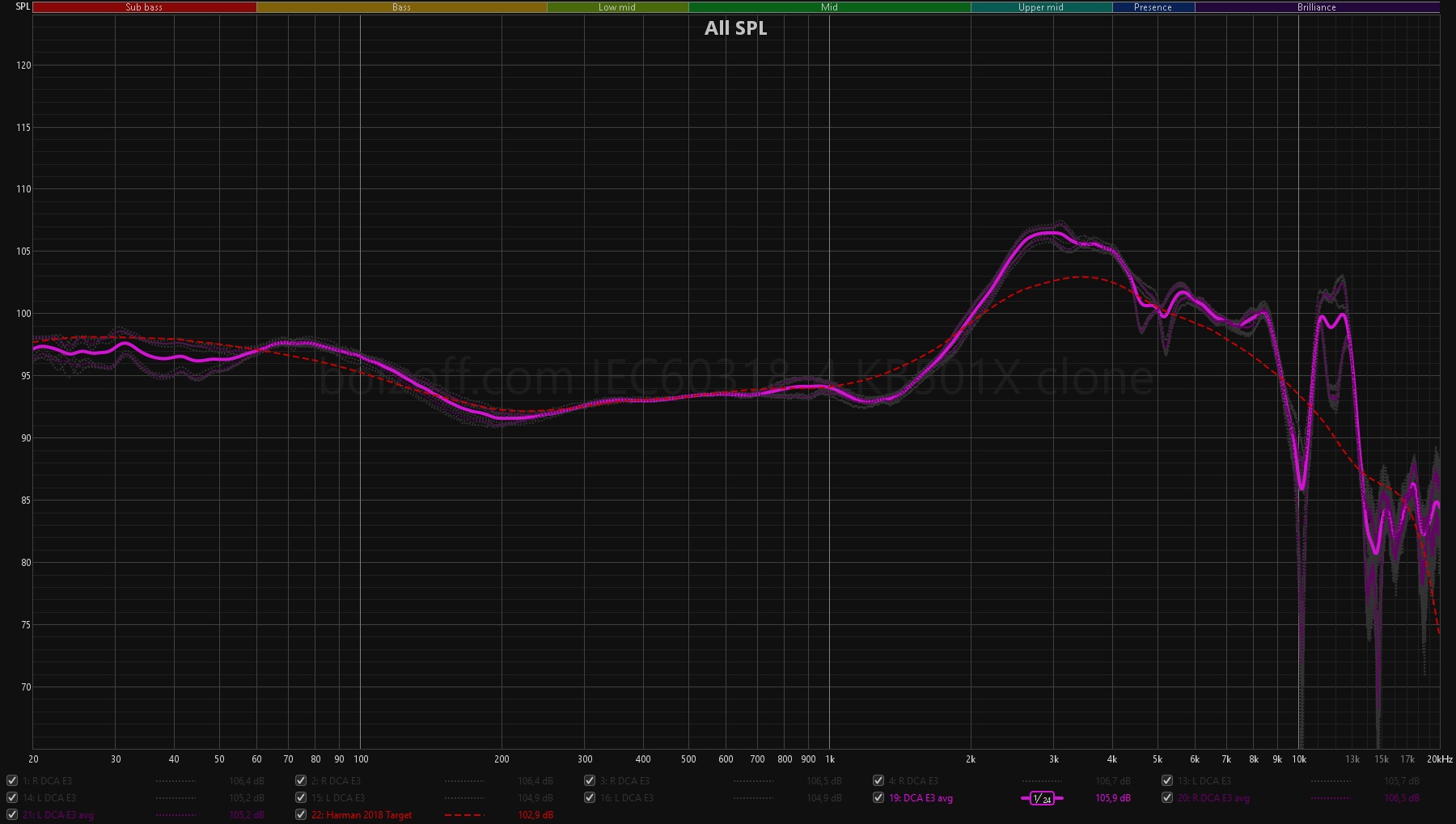
Here I can say as follows:
- The headphones were clearly designed with an eye on the Harman curve and generally correspond to it well;
- the subbass must be heard;
- the upper middle section is accented;
- the section at around 7 kHz sounds incredibly smooth;
- the frequencies above 10 kHz are really ‘not strangled’.
For the headphones worth $2,000, the left/right volume balance leaves much to be desired:
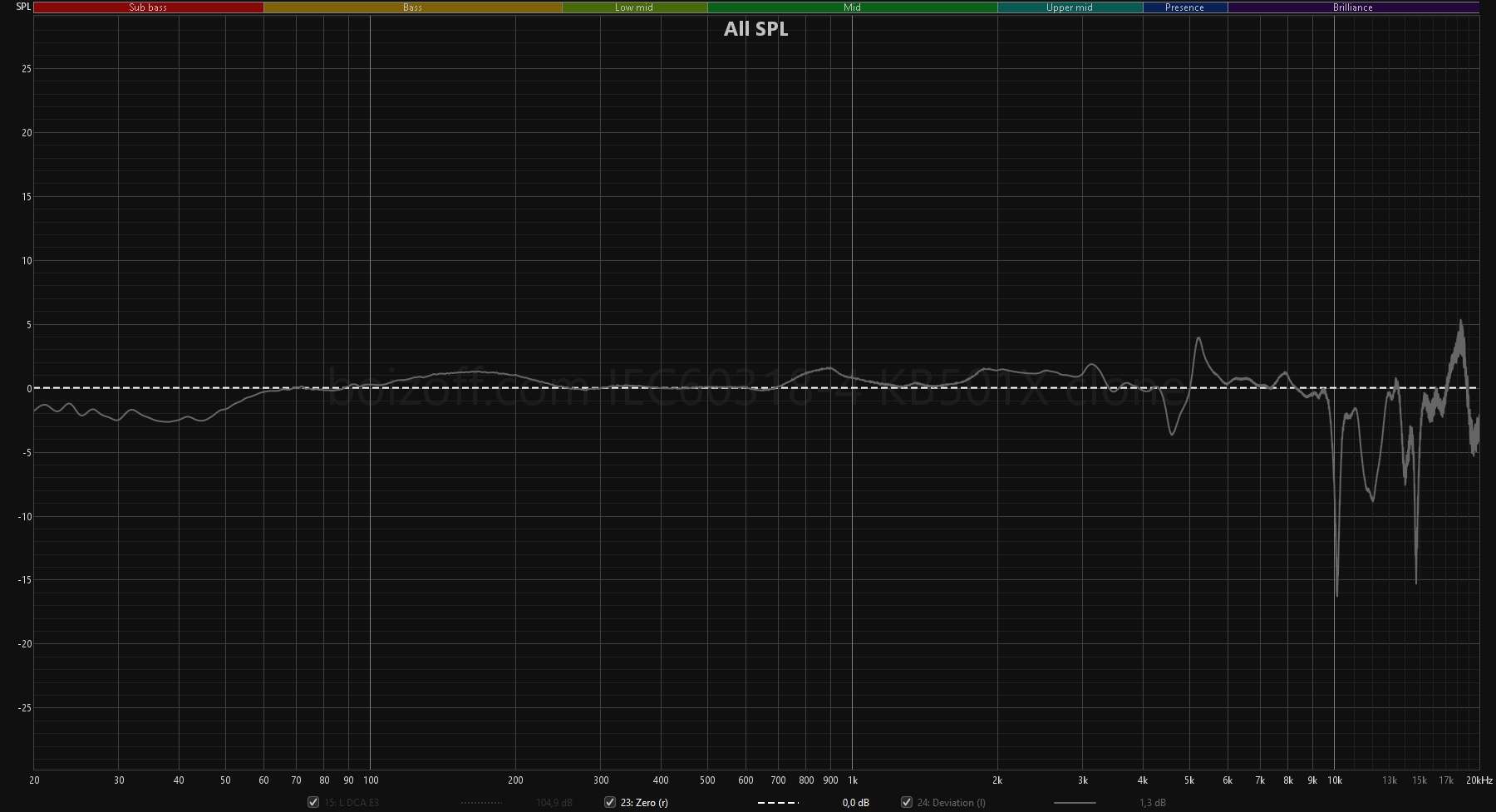
Nonlinear distortion for the left headphone driver at 94 dB volume is OK:
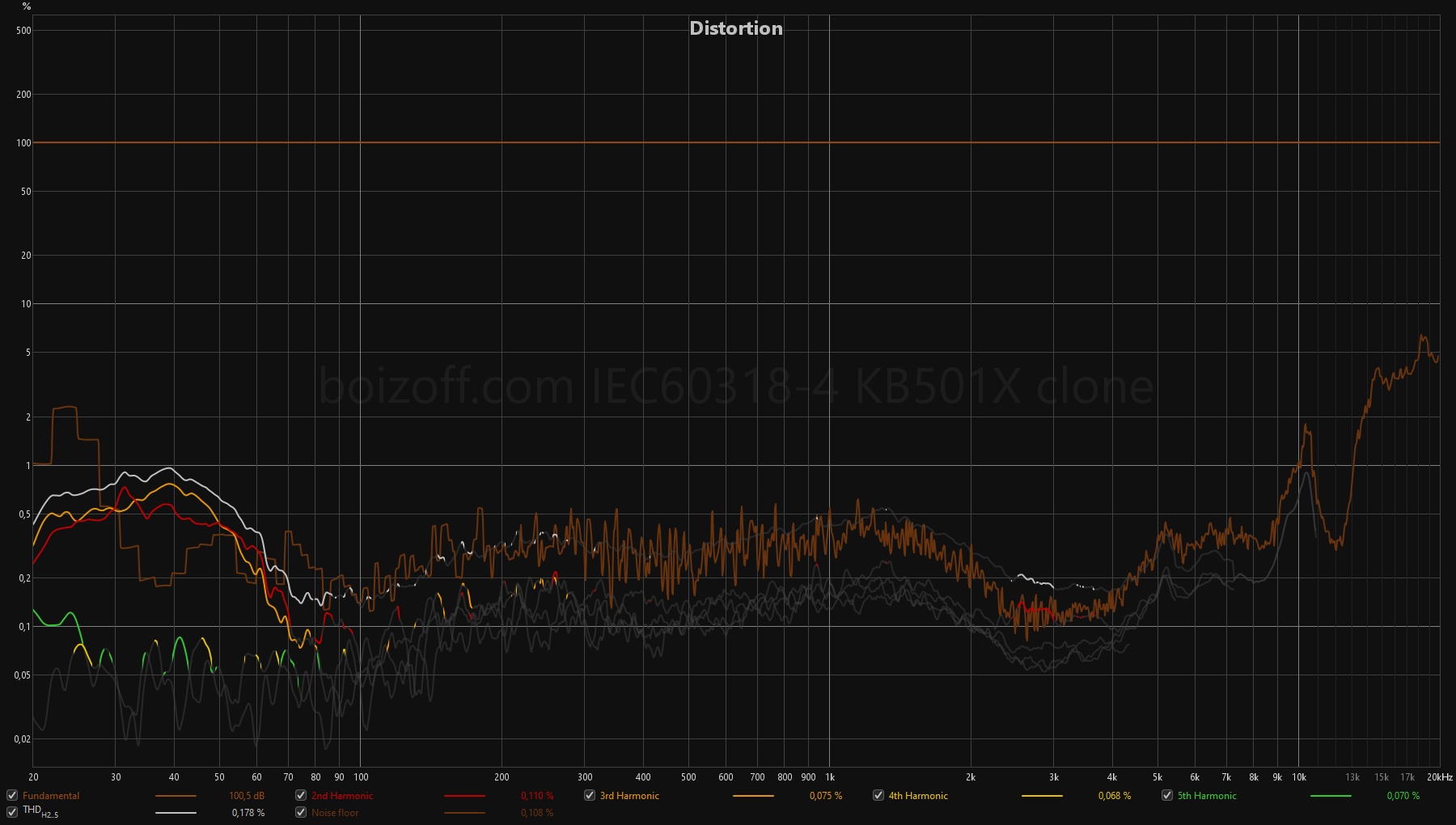
Nonlinear distortion for the right headphone driver at 94 dB volume is not OK at all. Look at 40 Hz:
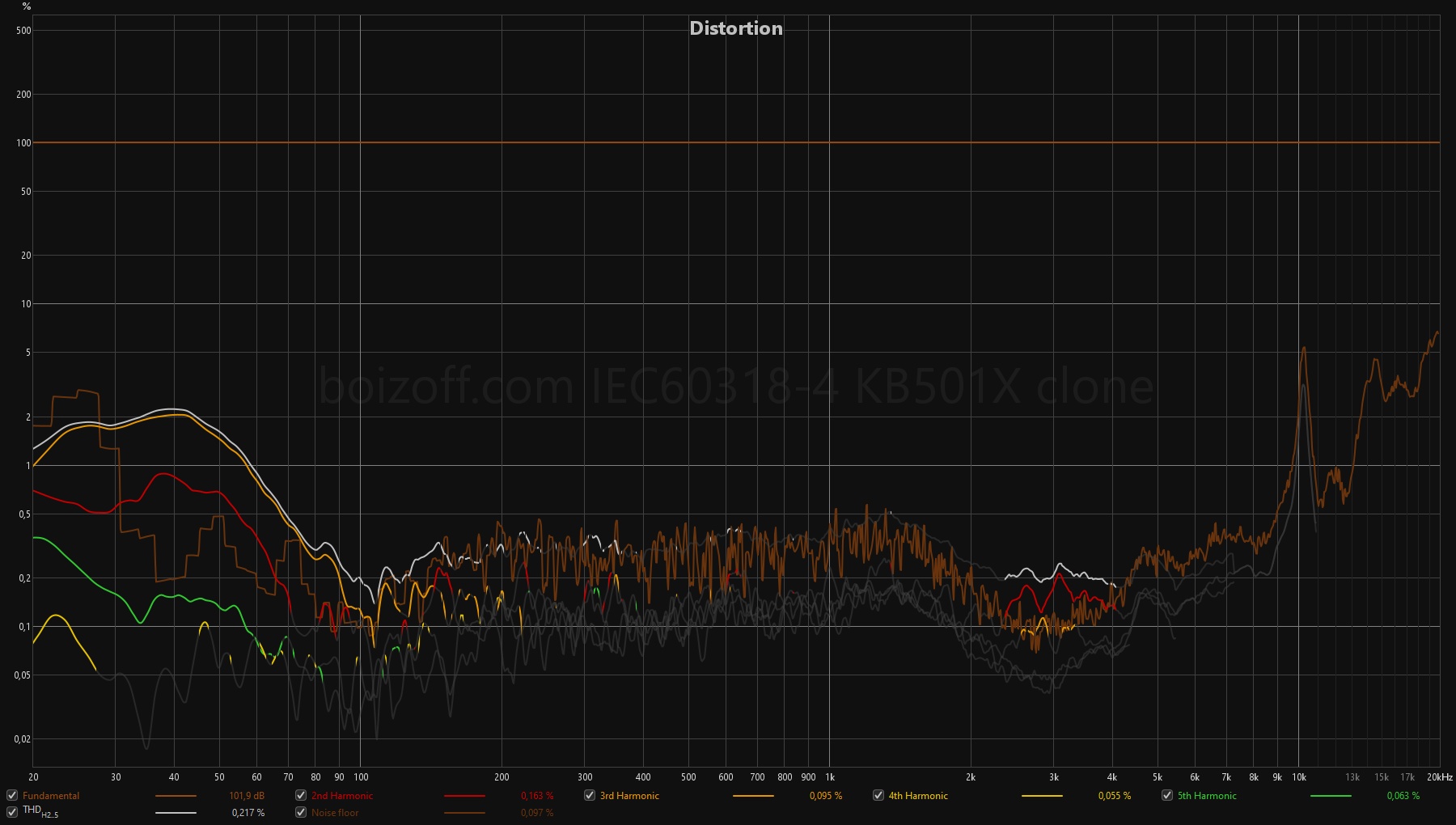
I’m really sorry, but in the context of the technical sound aspects (and manufacturing quality control), E3 is not a masterpiece at all, taking its cost into account.
The dependence of the frequency response on turning of the headphones around the horizontal axis is here, mainly impacting on the range above 10 kHz.
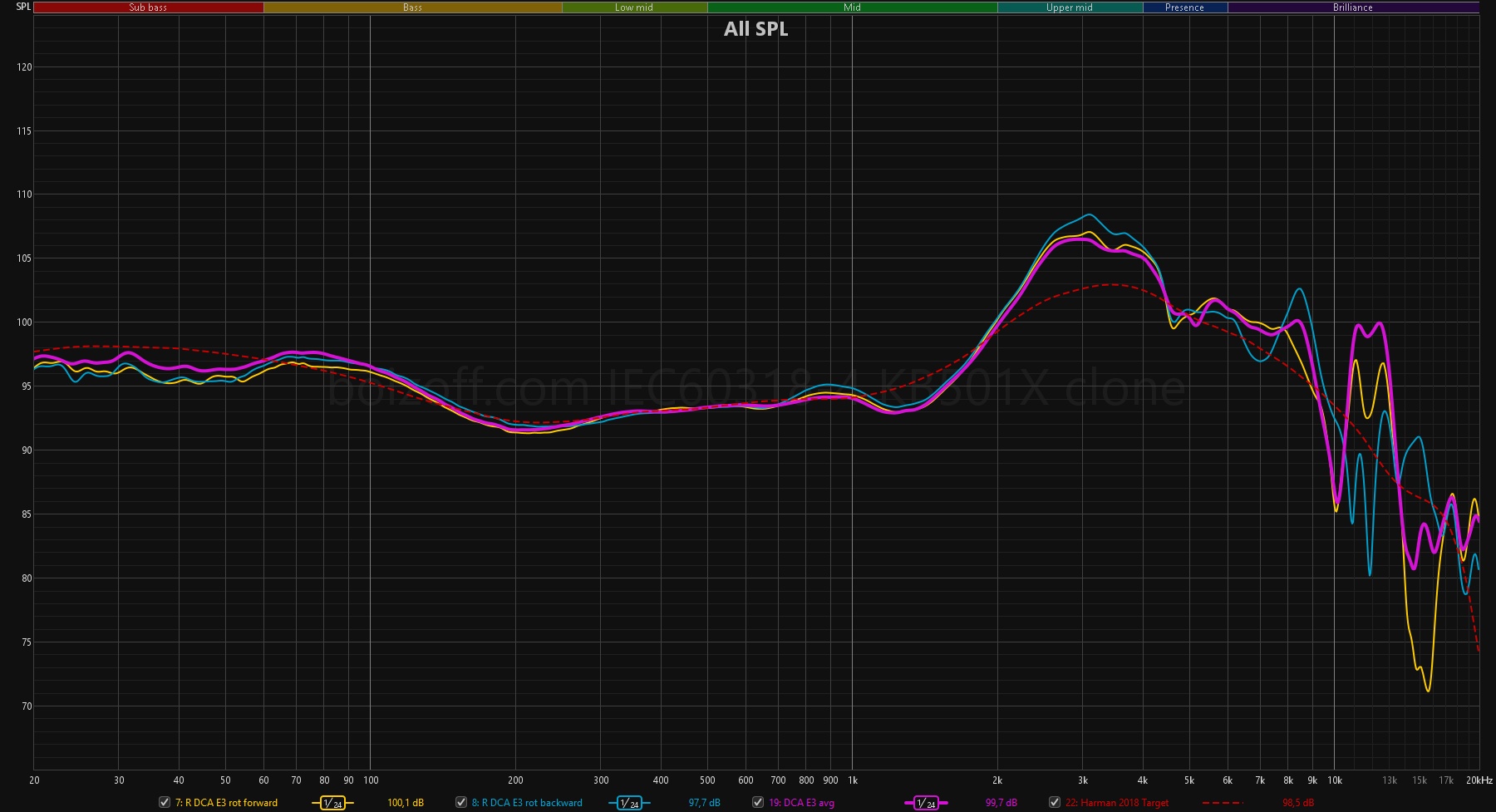
This is the dependence of the frequency response on the shift of the headphones up and down. When shifting down, all frequencies are ‘pressed’, starting from 3 kHz.
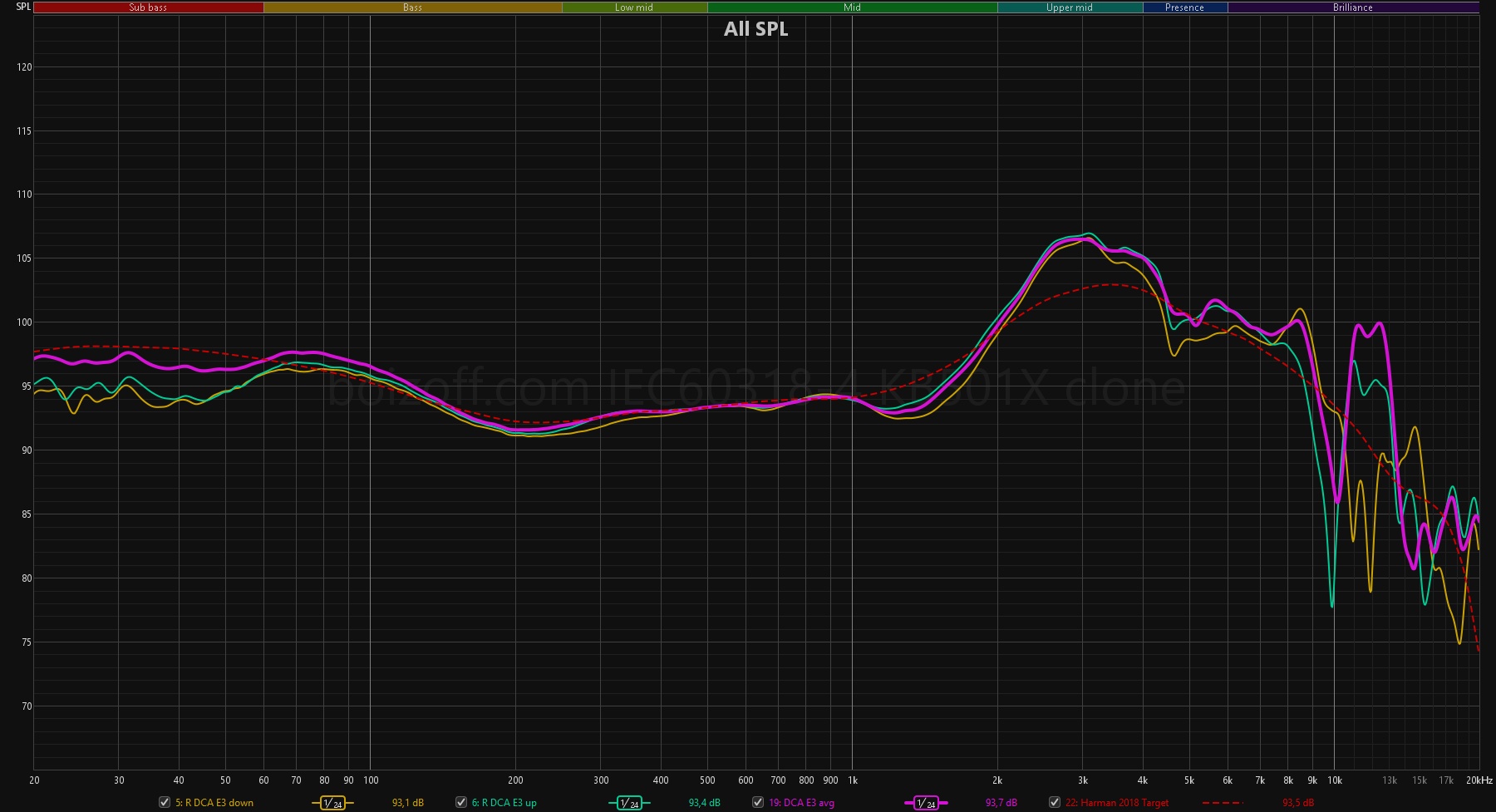
This is the dependence of the frequency response on the shift of the headphones back and forth (to the nose – to the back of the head). The forward shift mutes the sound delivery at 2.5–5 kHz. If it seems to you that the headphones sound too intrusive, too ‘close’, then shifting E3 noseward will let you somewhat fight off this feature.
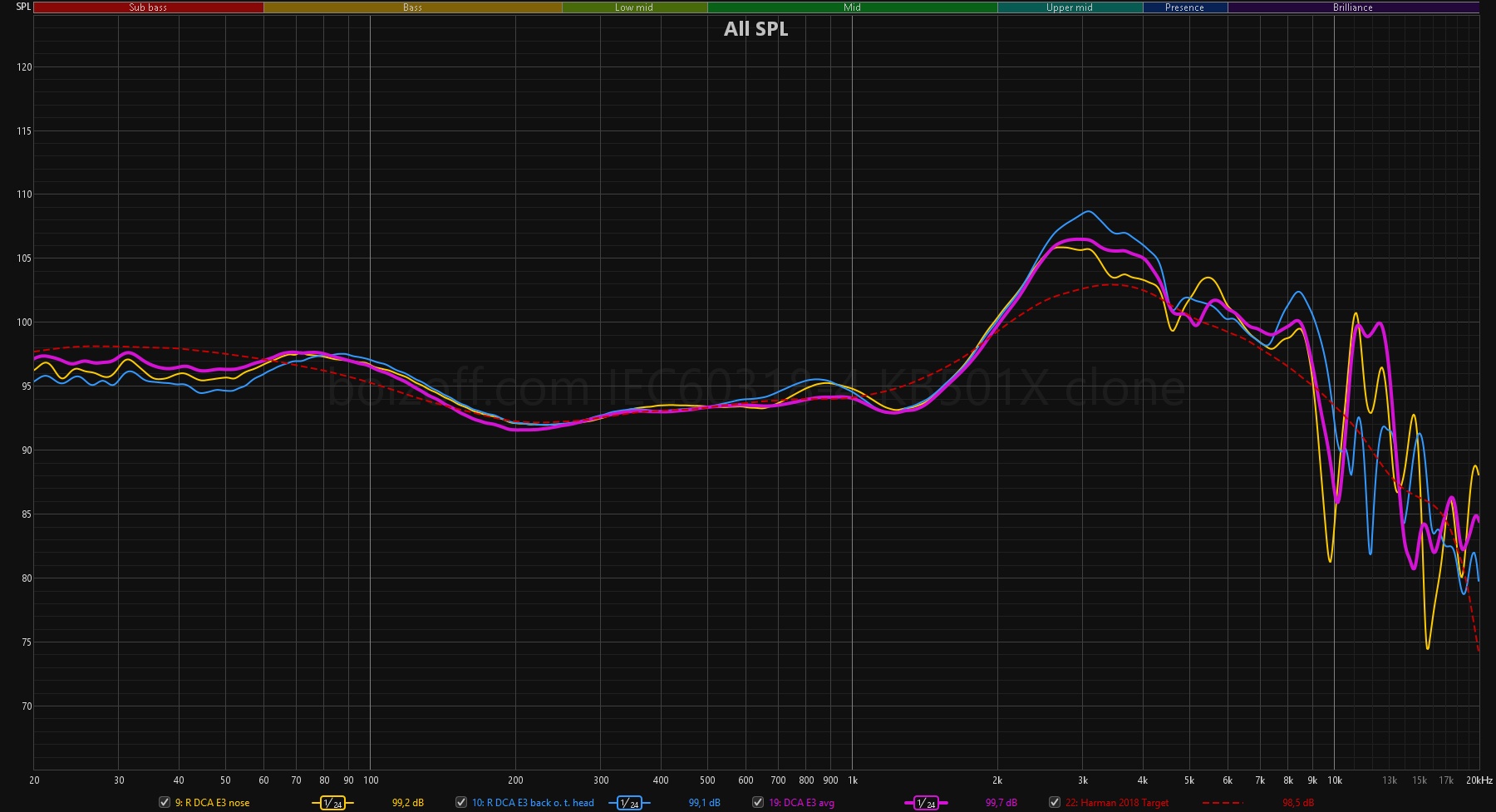
From all of the above, we can conclude that if you think that the headphones sound too vibrant, too ‘middle-like’, you should try to move them down and forward.
Comparisons: E3 vs. Arkona
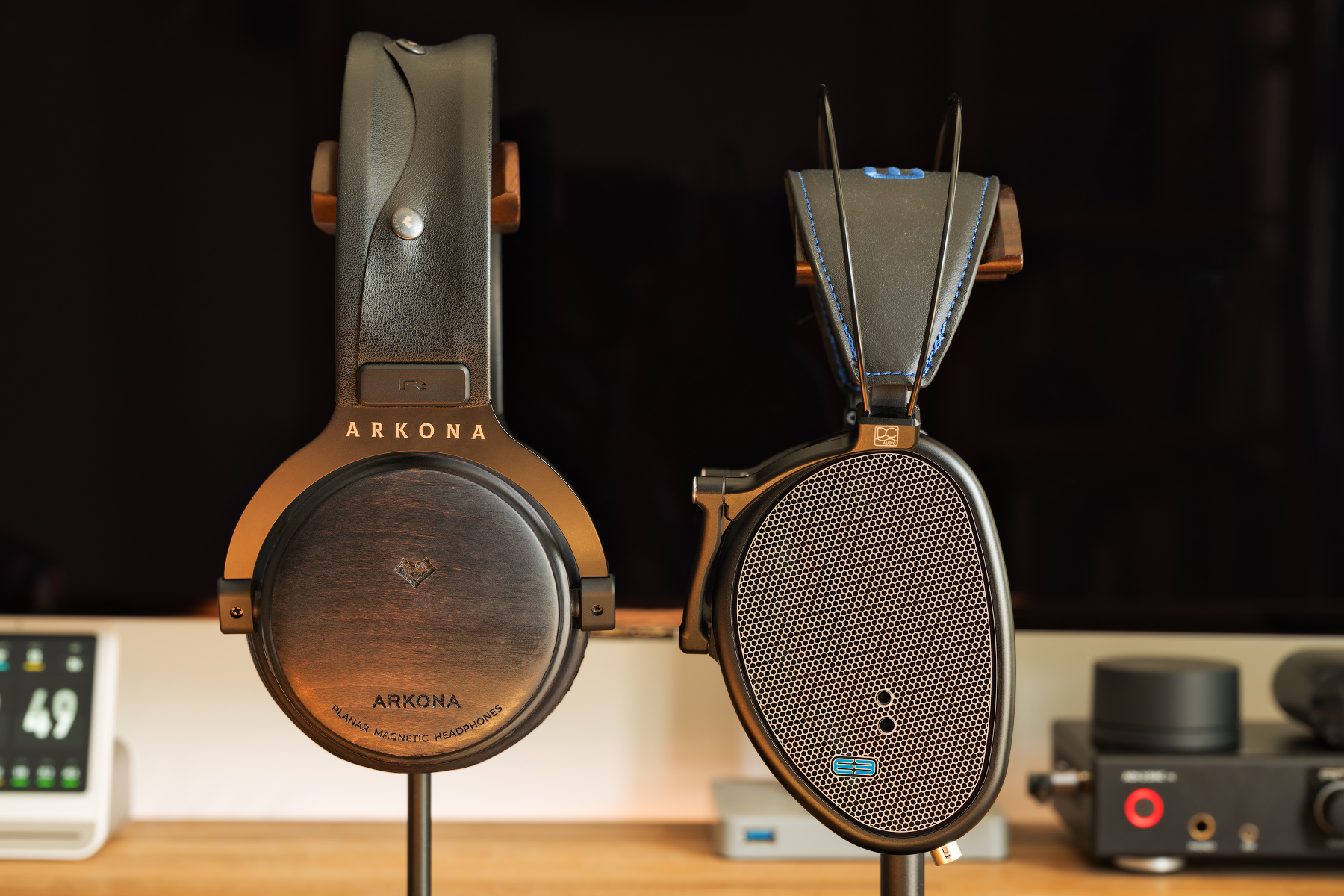
The ADC E3 and Kennerton Arkona frequency response graphs compared:
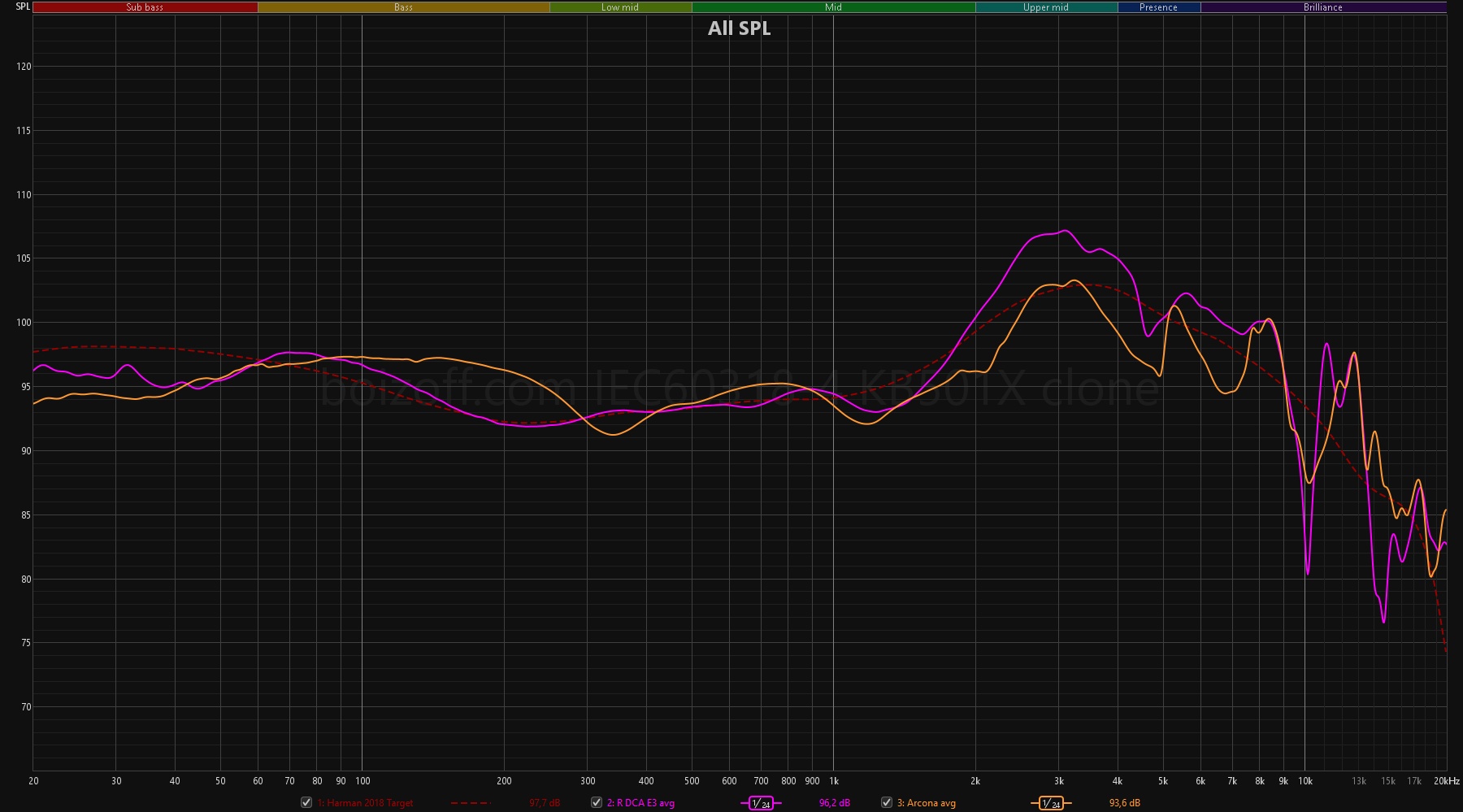
Subjective difference in sounding:
- Arkona sounds significantly weightier than E3.
- Arkona’s bass seems sharper as compared to E3.
- The E3 sound seems to be more ‘analytical’ as compared to the Arkona sound.
- The Arkona’s sound is perceived as more ‘comfortable’ as compared to E3.
Compared to each other, the Arkona’s sound can be described as more ‘subjective’ and ‘V-shaped’, whereas E3 sound more neutral and even lightweight. Overall, both models have a quite neutral sound delivery, but E3 focus on sound balance and the dominant upper midrange, while the Arkona sound has a more pronounced bass component (4 dB difference at 200 Hz as compared to E3), and it’s less aggressive in the range from 1,500 to 5,000 Hz.
And I can’t help but give a comparative assessment of the design solutions: it will be very difficult to repair E3 due to a large number of glue bonds, while Arkona can be disassembled and assembled with ease. E3 is not designed to experiment with earpads, whereas Arkona lets you change them in no time. Arkona uses popular miniXLR connectors, while DCA uses SN-8-4, which are rare for the audio world. Last but not least is the source: E3 requires more power to swing.
However, Arkona does not fold like E3 and weighs 100 g more, which is very significant.
Lastly, here are the measurements of Arkona’s nonlinear distortion at 94 dB volume, the worst of the two drivers:
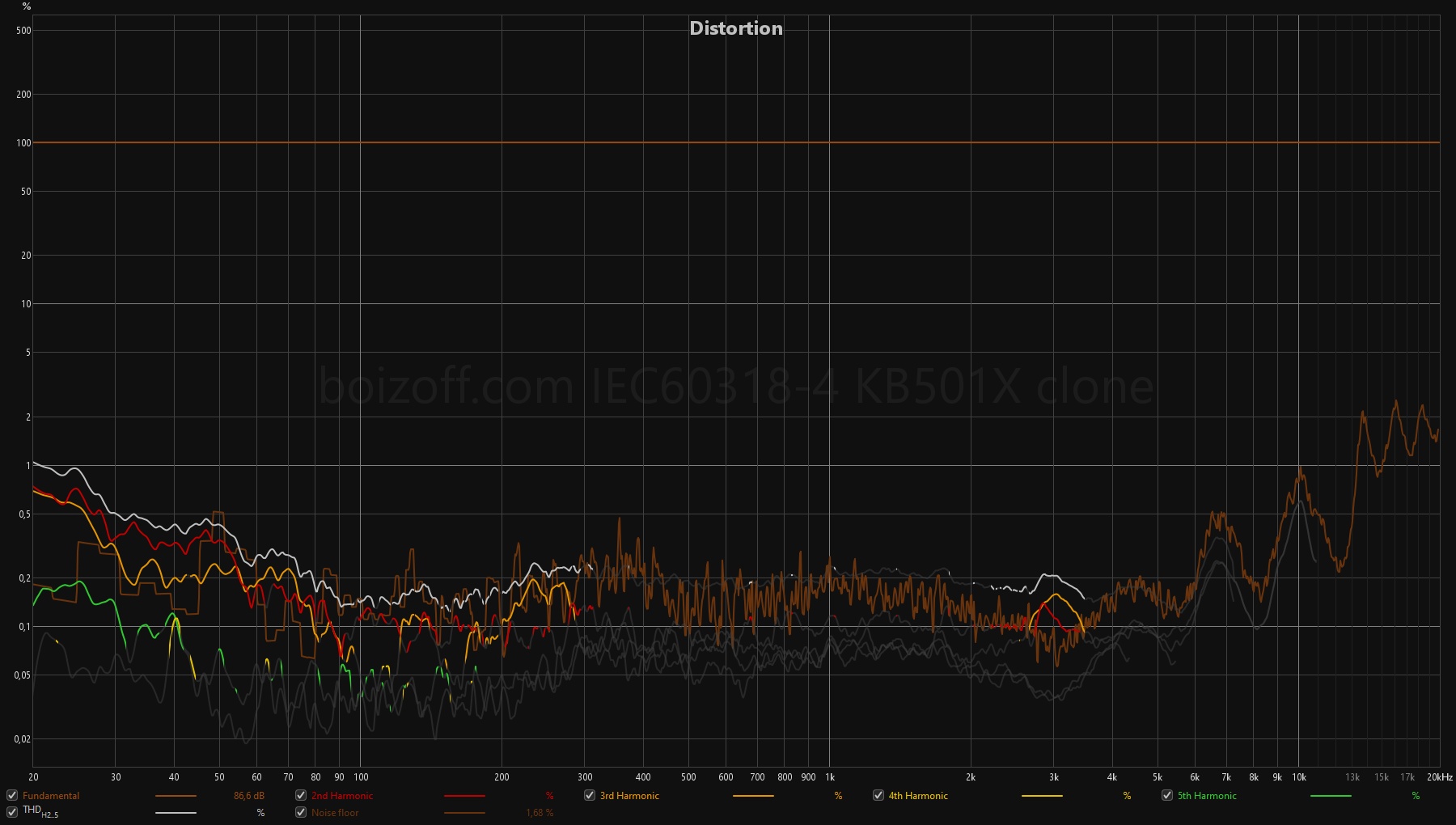
Compare them with E3:
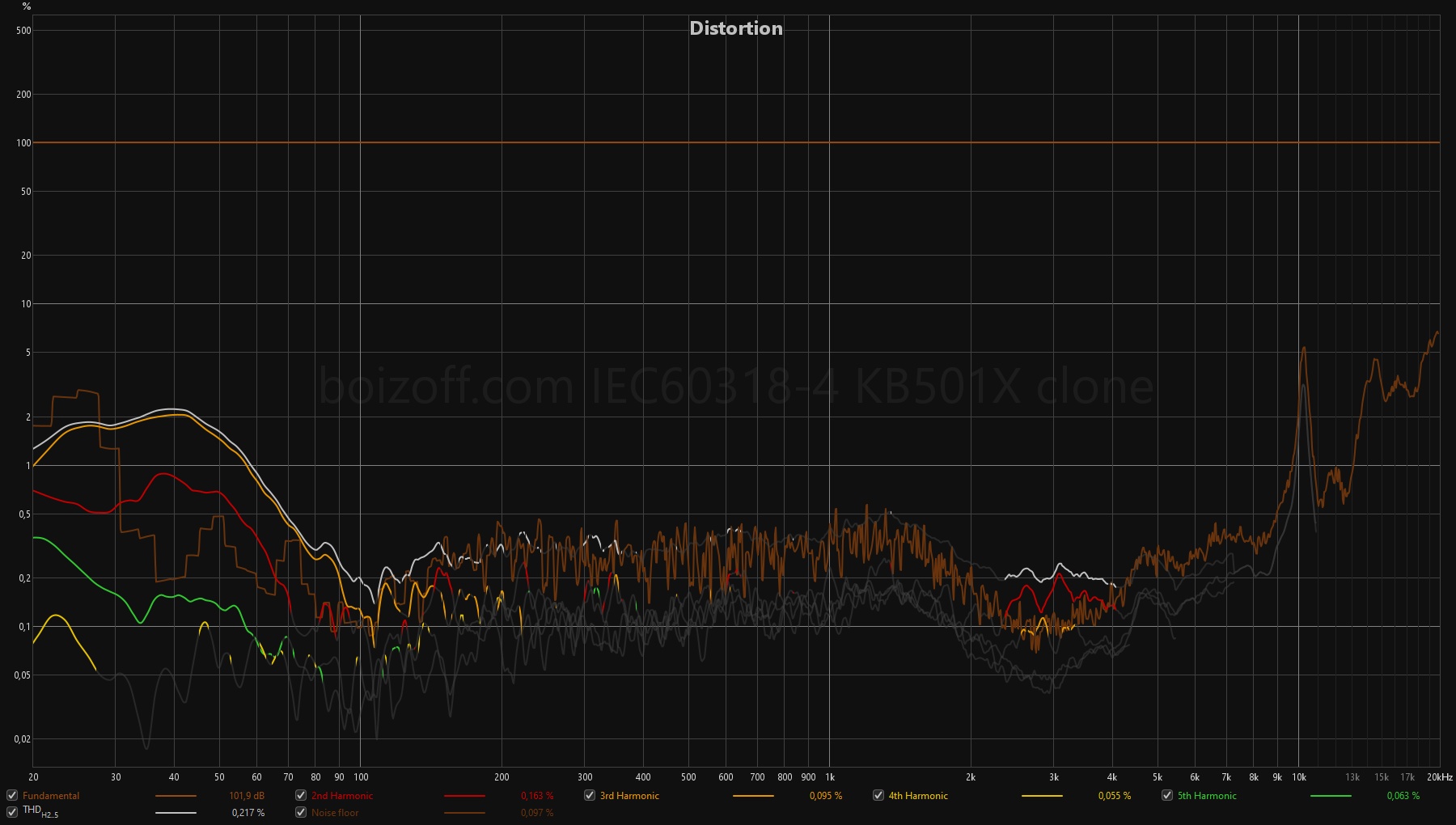
Summary
E3 are a very, very good pair of headphones: perfectly balanced sound, which will be primarily appreciated by fans of neutral sound delivery, comfortable fit (with nuances), an ability to fold the headphones for storage and transportation, a complete case, and low distortion levels, at least above 70 Hz. It’s very, very difficult to implement it all in a closed-back model.
On the other scale, there is low repairability, an inconvenient cable, unique connectors, earpads glued on, obvious problems with quality control, and a large number of differences in the sound of the left and right drivers.
The choice between them and Kennerton Arkona is quite simple: if you like headphones with precise, scale-measured sound, which don’t take any liberties ever, then E3 are definitely your choice. If you want a less accurate, but more ‘lively’ sound delivery, no hassle with cables, no problems with potential repairs (especially for residents of Russia) or with strange fit, then you need to pay heed to Arkona. And what’s more, they will cost you a little less.
To buy or not to buy: only after fitting, listening and a balanced assessment of all the pros and cons.

